 JacobCoffinWrites
5h ago
•
100%
JacobCoffinWrites
5h ago
•
100%
Good points! I suspect the 'even thickness' thing came from broken up concrete pads/sidewalks/patios, where the result would be irregulary shaped on X and Y but somewhat consistent for Z depending on how well they prepped the site for the slab. In that case it might end up pretty similar to landscaping rock. In some of the photos you can see they have a much flatter top and much more irregular edges and undersides.
100% agreed on demolition practices. There's a lot of potential in deconstruction for reclaiming building materials rather than consigning them to the waste stream. The tradeoff is in time, person hours (my grandfather once claimed a truckload of bricks from a demolished mill to build the family fireplace - my mother and her siblings weren't allowed to come inside that summer unless they chipped cement off some bricks and brought them with them). And in materials/energy - blades for a concrete saw and power to run it, perhaps. I'm sure there are other ways to get more-or-less regular building blocks but they'll have some cost to balance against the good of saving the materials and reducing the need for new manufacturing. Either way, there's some cool potential. Treating rubble or urbanite like quarried stone I think fits the solarpunk ethos.
Thank you for the details on bonding concrete! I've used cement to patch some holes in custom-shaped, 45° concrete blocks I made once (didn't shake all the air pockets out of the first couple) so I knew you couldn't just stick concrete to concrete, but not how to actually go about it when you had to. I'll refer back here if I need to fix it someday, or if it comes up in any of my stories.
Thanks!
 JacobCoffinWrites
3d ago
•
100%
JacobCoffinWrites
3d ago
•
100%
Thanks! I'm very much not nautical so take this with a grain of sea salt. I think yeah, able to travel faster and use weaker winds, plus perhaps better handling in whatever conditions the hull was designed for. The person I was talking with mentioned that the original hull from the windcoop looked like ones meant for the north Atlantic where it'd be dealing with short choppy waves. Presumably this one would heave up over them a bit more than the original, so it'd be a less-smooth ride. That might mean more wear and tear? That'd be a trade off they'd have to assess.
I think generally I very much want to depict a slower society, one that's actually willing to take an efficiency hit if it means protecting animals, or habitats around it. That sort of consideration is sort of unthinkable in our current world, but yeah, I think it'd be worth it. Hopefully looking out for whales is a small piece, indicative of a much larger cultural theme.
Similariy, I hope that this society is configured differently enough, paced slowly enough, that it can tolerate some unreliability without issue. I imagine they have some high-priority, guaranteed-fast shipping for important stuff like aid, medicine, food, but that the rest of their shipping might show up late or early depending on the favorability of the weather, and that people expect that. I think that might be a general theme in a lot of areas of life - they've looked at the tradeoffs and decided that the convenience isn't worth the cost in externalities. Sort of heresy to a modern American (or so it feels in some of my IRL conversations) but plenty of societies, including our own, got by that way.
 JacobCoffinWrites
3d ago
•
100%
JacobCoffinWrites
3d ago
•
100%
I dunno, I could kinda see it - they don't understand a ton of their own tech, and have folded religious belief into even basic maintenance routines until they can't tell whether lighting incense or chanting as they work changes the outcome. I don't know about the admech, but the imperial guard types seem to believe every device from a heavy bolter to an ancient and venerable space marine tank are all equally likely to have machine spirits animating them - presumably they got that thinking from their tech experts. There's also the sort of outlined belief that tech is sort of... naturally occurring? and that it's heretical to invent new stuff when the correct process is to discover it somewhere.
Add to that the fact that the quality of their tech has declined pretty drastically from their past (aren't most STCs, which they basically worship as the best of their modern tech, like the crude, sturdy equipment you'd give a colony that was just starting out?) and the fact that some of it is sometimes possessed by literal daemons or other ancient abominations... it sort of seems like they're in over their heads compared to the others.

I’ve been wanting to do more scenes of solarpunk ships. Shipping underpins a huge amount of our society and I think building a more solarpunk world will mean changing it in some really interesting ways. Last time I did [a ship in a storm](https://jacobcoffinwrites.wordpress.com/2024/08/20/ship-in-a-storm/), but I wanted to do something a little more bright and happy this time around. A month or so ago [I was talking with a sailor on the solarpunk subreddit](https://www.reddit.com/r/solarpunk/comments/1fbb70b/comment/lm12m2u/) and I asked if there was anything they’d like to see in nautical solarpunk art. I was kind of looking for design ideas but what they gave me was better –an excellent list of experiences and details which stood out from their voyages, one of which was the way whales come right up to sail ships because they’re so quiet and the whales are curious. So I started looking for art of ships and whales to reference, and (of course) almost exclusively found of paintings of whalers killing and carving up whales (which put a kind of tragic tinge on that wholesome description of their curiosity). So I figured that was my next subject – I wanted to do a scene with a similar composition to those paintings, but with the ship very clearly hauling cargo, and the two subjects just sort of harmlessly crossing paths. The trouble is that with a lot of ships (especially sailing ships), it can be hard for most of us to tell its purpose from a distance. Container ships are kind of the exception, so I started looking for the rare combination of sail ships that can haul containers, and sort of went down a rabbit hole as I learned more both about our current shipping and proposed designs. I ended up collecting so much information in the course of that reading that I’ve actually put together a second post just with information for solarpunk writers and artists who want resources for nautical solarpunk](https://slrpnk.net/post/14284744). I’m very much not an expert but I hope it hits the level of detail most folks need to get started and that it consolidates it nicely in one place. By far the best luck I had with all that was in reaching out to the Naval Architecture subreddit, where I found a handful of folks with the patience of saints willing to [answer my questions](https://www.reddit.com/r/navalarchitecture/comments/1fvfaj0/a_question_about_modern_sail_ship_designs/), provide all sorts of resources I’d missed, and who walked me through drafting this junk-rigged-cargo-ship-with-offset-masts design. I can’t thank [Open_Ad1920](https://www.reddit.com/user/Open_Ad1920/)and the others enough for all their help! I’d started out unsure of whether I wanted to do a more traditional ship design to better match the old whaling scenes I was riffing on, or to lean in on some of the more modern concept art I’d found to better contrast it. I ended up taking the proposed windcoop container ship and changing it to follow recommendations from Open_Ad1920. They had a lot of interesting design ideas for a sail-based modern container ship and I basically decided I wanted to go all in on their dream design and see what it looked like, rather than copy a company’s concept art. I’m glad I went with a more modern design now, because I was able to make it look less sleek and more like a modern working vessel (with a paint scheme copied from some real life container ships). I think that reflects some of my goals in the postcard series of showing the less-pretty, industrial kind of spaces that underpin even a solarpunk society that tries to co-exist with nature. Speaking of which, one of their recommendations was modifications to the hull of the ship to make it safer for whales. Whales are sometimes hit by ships (they sleep just below the surface and don’t know where human shipping lanes are). Some hulls are more dangerous to them than others. Ships with steep, sharp prows and [bulbous bows](https://en.wikipedia.org/wiki/Bulbous_bow) are apparently especially dangerous for whales. If you search for ship hulls and whale safety, you’ll find an unfortunate number of photographs of a dead whale draped over one of those bulbs. One of their suggestions was to change the prow of the ship so it was angled forward, with no bulb below the surface, and a much more rounded/blunt bowstem. This design will likely lose some performance benefits while underway but if it hits a whale I guess it’s more likely to sort of dunk them rather than to slam into them like an axe. The [notes post](https://slrpnk.net/post/14284744) and [this conversation](https://www.reddit.com/r/navalarchitecture/comments/1fvfaj0/a_question_about_modern_sail_ship_designs/) go much deeper into some of the design choices, but there’s a few other interesting aspects to call out here: As they explained it, cargo cranes aren’t as inconvenienced by masts as you might expect, but bridges built after the age of tall ships block a lot of important ports, so folding masts are necessary just to reach the dock. Junk rigs like the ones in the scene are apparently well-suited to folding and offer decent performance. They also recommended placing the masts on the ship offset from the centerline, in a sort of zigzag pattern, two on each side. As they explained it, this gets more masts on the ship, without going extra tall or messing up each others’ lift over drag ratio. I’ve poked around and found a few examples of offset masts (on flat bottomed boats, proas, or catamarans) but not much like this. Most of their other suggestions for reducing draft and maintaining control underwater are hidden by the ocean. To paraphrase their suggestions, "the vessel has either a lifting keel or daggerboards. It also has at least two rudders, if not more, to get sufficient area. The rudders might end up as transom-hung folding types to reduce draft and maintain good performance under sail. A long, thin rudder works best. Racing monohulls of all sizes have been built this way and they work well while avoiding rudder damage from impacts." The whales in the foreground are blue whales,just sort of swimming alongside.
 JacobCoffinWrites
5d ago
•
100%
JacobCoffinWrites
5d ago
•
100%
It's a cool idea but I think sailors would really hate it. Loose containers floating like manmade icebergs seem to be a sort of universal fear among sailors if the articles and forum posts I've found are anything to go off of:
I stumbled onto this one awhile back while reading about sailing container ships and read it because it was interesting:
I found this one while looking for the first one: https://www.yachtingmonthly.com/sailing-skills/how-big-a-risk-are-shipping-containers-32722
And this one was kinda interesting too: https://oceannavigator.com/a-legendary-offshore-danger/
There's lots more, seems like every sailing publication has run at least one article on this subject (and apparently there's lots of sailing publications!).
And that danger (real or imagined) is with only a few thousand containers going in the drink per year (less than 1% of the total currently traversing the oceans). Deliberately moving more of the fleet that way would be a big increase.
Those fears/articles are proof they can float already, though that's usually because of the packaging (styrofoam packaging wrapped in watertight plastic etc). But what stood out to me (I think in the second article) was how flimsy, cheap, and poorly maintained the current fleet of containers is. And it makes sense, they get used constantly and banged around as they're lifted, stacked, stored, moved. But that damage comes while also doing fairly light work compared to what you're thinking of - they just sit stacked up, they don't have to traverse oceans on their own or drive or anything. To do that they'd have to be much stronger, (they're not currently reinforced except at the ends which is why they can't be buried to build survival bunkers), most aren't very watertight, and they're simple, without the mechanisms for sailing or driving. And even still they're failing their jobs for lack of maintenance.
I think it could actually be a really interesting concept for a fiction setting - the hazards posed by rogue, damaged, leaking containers could be a good plot hook, the potential for high tech piracy, hacking to redirect them or just stealing them out of the ocean, could feature in all kinds of plots. It might be a little more cyberpunk but I'm a huge fan of that genre too and write in it occasionally so I think there's a lot of potential there.
 JacobCoffinWrites
5d ago
•
100%
JacobCoffinWrites
5d ago
•
100%
I think a couple big cargo ships, including Norsepower, are using them. Apparently they provide some provable savings in fuel consumption, even with the energy consumed to spin the rotors to get the sail effect. It sounds like the main advantages over sail is in integrating very conveniently with modern motor vessels (easy to use/control by changing spin speed, the slender shape leaves it out of the way of the cargo hatches/holds).
I think they fit the "basically a normal cargo ship with some begrudging compromises for fuel efficiency" school of green ship design. I think the progress they represent is really important and the amount of fuel saved even by partial measures is incredible (thousands of tons per trip in one case). It wasn't what I was looking to make art of when I began reading so I'll admit I went kinda light on them in the post.

# Nautical Solarpunk: I've been reading up on modern sail ships and asking questions while working on some solarpunk sailing artwork. At this point, I think I have gathered enough information that it might be useful to someone else. So if you want to include ships in your solarpunk story (even just mentioned in the background) or you’re looking for references for some artwork, take a look. I’m very much not an expert, but I’ve been pestering some of them, and collecting examples from the internet and doing my best to organize it. Hopefully this by-laymen-for-laymen approach will help make it accessible without leading you astray. One thing to note up front: there’s a ton of variety here. Historical nautical terminology is remarkably chaotic – probably because most of it predates manufacturing practices that involved standardization. Highlights include the fact that ships can be classified based on size, sail plan, rigging, hull type, how they’re used, some combination thereof, or whether they have a figurehead or not. Modern sail-based freight shipping is still very new and I get the impression that the industry as a whole is sort of picking up old ideas and new ones and trying them in different combinations to see what fits. There are very few finished examples underway out in the world and I’m not sure we’ll know what designs are the absolute best for which use cases until a lot more ships have been launched and put to work. That said, I think we’re definitely going to see a resurgence of sail and it seems like there’s a decent amount of interest and enthusiasm in the industry, even if many are understandably nervous about making huge changes when those changes involve incredibly expensive ships. # Why sail? It’s the original zero-carbon (-ish, they deforested huge amounts of land and destroyed entire habitats to build ships back when) shipping and transportation system. We had the technology to move cargo and passengers using the wind to directly do most of the work, and we have the technology (metal hulls, automated rigging, satellite navigation systems, radio, etc) to do it much more safely than our ancestors could. Even if a shipping company isn’t motivated by regulations or pure environmental reasons, oil will get more expensive eventually and that will cut into the profitability of giant motor vessels. # How shipping might change: Modern day shipping is extremely cheap but only when you limit the metrics you track to money. When you account for the pollution, the waste, it gets a lot harder to justify. A huge part of keeping modern day cargo shipping cheap is using the absolute worst fuel (bunker fuel, tar-like stuff left over after distilling and cracking petroleum, which is contaminated with everything the fuel they were actually making couldn’t include), as soon as they hit international waters. I think a solarpunk society is one that cares about externalities. I genuinely like the optimization and logistical advantage of using standardized, stackable shipping containers which fit on ships, trucks, and trains without the need to load and unload the cargoes by hand at each transition in their journey. That’s great stuff, no complaints. What I wonder about is if the cost efficiency brought by combining containerization with ever-more-massive, bunker-fuel-burning ships has caused other problems. We ship cargo all over the world but much of the time, we do it because it’s so cheap to do so. Many of those containers are full of cheap tat that ends up in landfills after one use or no use at all. We ship raw material from one continent to process it on another, we ship that material to another so it can be shaped into parts, which are shipped away for partial assembly on another continent, and then again for final assembly. Is that efficient? It’s cost efficient. But we burn terrible amounts of fuel each time we do it, and we do it for so many things. When you read through the handful of real sail ships operating today, a theme becomes somewhat clear – these early (for profit) ones at least are primarily transporting the same high-value or location-specific cargoes sail ships were carrying a hundred years or more ago. Wines, champagnes, and other liquors, raw coffee, raw cocoa, luxury goods like that. This is partly because they need to justify the up-front cost of standing up a whole new kind of shipping, because they’re often slower, and because there are already crew shortages even before getting into the specialized skillsets related to sailing by wind. So they’re currently prioritizing the kind of specialty products (that only grow in certain climates or need special skills or reputation to produce) that exist in one place with markets in others, where they can markup for greener shipping. As they expand, the range of products will no doubt expand as well - cargo ships used to carry all kinds of stuff. But even with massive fleets (to make up for the fact that it’ll be hard to make single ships as big as we have now for reasons I’ll get to) we probably won’t see shipping done as cheap as it is today. Generally I think this lines up well with solarpunk principles like building to your local environment using local materials, manufacturing things locally, and building them to last and to be repairable. Shipping would fit the things that have to come from somewhere else. # The motor to wind spectrum: I think it’s safe to say that almost any ship is going to be some kind of hybrid between motor vessel and sailing vessel. What ratio of wind to other energy (electricity, biodesiel, hydrogen, bunker fuel) is up to you. I will say there’s potential for a timeline here, starting with the majority being modern-day cargo ships with sails bolted on saving around 20% of their fuel, and transitioning towards more numerous, smaller ships using more and more wind, until the bulk of the fleet is primarily-sail ships with auxiliary motors or engines for maneuvering in port and dealing with emergencies. And chances are good that ships from all over that spectrum will be sailing at the same time. # So what does modern-day shipping look like? We should cover the current landscape a little so you know what the new stuff is competing with or building on. Most of the sites I’ve read break cargo ships into a few big categories: **Container ships:** These are apparently the most common and probably for good reason. The convenience and efficiency of shipping containers allows for some real benefits. Cargo can be packed into a 20′, 40′ and 45′ long container, transported by truck or train to a port, loaded onto a ship, transported to another continent, lifted onto trains and trucks and not actually unpacked until it reaches its destination. When the alternative is people physically carrying stuff onto the ship and packing it into the hold, and carrying it out and packing it into a truck, you can see where there’d be some advantages. (Palatalized cargo is a sort of great middle ground that allows for better weight distribution in the hold (you want the heaviest stuff near the bottom so the ship is stable) and can be loaded very similarly to how containers are (you move the entire pallet, so it doesn’t get unpacked until it reaches its destination) but that’s not super relevant at the moment.) The big modern container ships can transport 85 TEUs (twenty equivalent units) to 15,000+ depending on their size. So far the [biggest primarily-sail design](https://www.wind.coop/en/the-sailing-cargo/) I can find can haul 100 TEU containers. Putting sails on these is kind of difficult because they use the deck for cargo space and will have cranes loading and unloading containers whenever they’re in port. Apparently this isn’t as big an issue as I expected, but it’s still something to keep in mind, especially if there’s tons of rigging involved in the design of the sails. There’s a ton of designs out there for adding big easy-to-use sails and kites to existing container ships in order to boost their efficiency and cut fuel use somewhat. They’re in use now and have some good info if you’re looking for hard numbers. I haven't really covered them in these notes much. I find container sailships to be the most interesting (something about the mix of old and new, and the fact that containers make the ship's purpose visually clear) so I’ve got a bunch of examples of them below. **Roll-on roll-off ships:** These ships are used to transport wheeled cargo, things like private cars, industrial vehicles, buses, trucks, construction equipment, excavators, etc. They usually have a huge door in the side or stern and the vehicles can directly roll on and off the vessel. They seem to be a popular choice for full-sail cargo ships because they don’t need to worry as much about keeping the decks clear for loading and unloading. How well they’ll fit in a solarpunk world is up to you – some vehicles and wheeled equipment will undoubtedly have to be transported overseas but whether there’ll be enough to justify this class of ship is up to you. Neoline is a good primarily-sail example of this type, Norsepower is a more traditional primarily-fuel version. **Dry Bulk Carriers:** These transport solid non-packaged loose dry cargo in bulk quantities. Think wheat/grain, chemicals for fertilizer, cement, wheat, sugar, coal, iron ore etc. Some of the last sail vessels in operation were bulk carriers, like the [Flying P-Liners](https://en.wikipedia.org/wiki/Flying_P-Liner), some of which were still transporting nitrates in the 1950s. Most of the modern sailships listed below seem to do at least some of this. **Tankers:** These ships transport large amount of liquid cargoes like petroleum products (oil, gas), chemicals, wine, juice, etc. in bulk. They are probably a good fit for a wider range of sail types since they don’t need to worry as much about keeping the decks clear for loading and unloading. **Reefer ships:** (Short for refrigerator) they’re designed to transport frozen/temperature-controlled cargoes, mainly in refrigerated containers. Food and perishable goods (fruits, vegetables, meat, fish…). I don’t have much info on these (except that I think a lot of the container examples should apply). I do suspect these would be one of the most challenging as they’ll need a lot of power onboard. # Considerations for sailing cargo vessels: This info is mostly pulled from [some excellent comments provided by the folks on the Naval Architecture subreddit](https://www.reddit.com/r/navalarchitecture/comments/1fvfaj0/a_question_about_modern_sail_ship_designs/), especially Open\_Ad1920. This is a simplified summary, there are definitely details I left out that you can find over there. **What kind of sails do you need?** The most obvious (to most of us) difference between motor vessels and sail vessels is the huge masts and sails on top. For cargo vessels, they seem like they should pose huge issues for cranes in the ports (in the case of containerized shipping) but apparently this isn’t as much of an issue with larger and more modern crane designs as I would have expected. The modern cranes lift their booms to allow tall structures past, then lower them to the working position. Apparently they already work right up alongside tall structures on modern cargo ships so masts should be similar. Where masts pose a problem is with going under bridges. Bridges often block ports and rivers where sail ships would like to enter. Most all of our modern bridge and port infrastructure was built in the days after tall ships had been replaced by steam and motor vessels, but that means there are trillions of dollars worth of port infrastructure that would be blocked to anything with a mast. This has been a major motivator for folding mast designs. Some sails are better suited to folding masts than others, so consider the routes and ports your ship would likely see, and whether it would need to get past bridges. Consider bridge height, the height of the mast normally associated with your ship height, and whether the mast needs to fold. If it does, consider which sails are well-suited to doing so. * Several modern/proposed designs like the Windcoop or Neoliner use rigid sails on masts that can apparently fold down. * Of the more traditional designs, junk rigs / Chinese lug sails / fully battened lug sails seem to be the best candidate for a folding mast and [are apparently pretty easy to use](https://www.kastenmarine.com/junk_rig.htm). Hasler & McLeod for more info. They may use curved battens that flip to orient the curve towards the tack in order to make close-hauled upwind performance comparable to that of a bermuda rig. If you need to understand those terms in order to write your story at the correct level of detail, you probably either know them already or are about to dive in to the world of nautical terminology, in which case best of luck! Lots more info [here](https://www.reddit.com/r/navalarchitecture/comments/1fvfaj0/comment/lrcua20/?utm_source=share&utm_medium=web3x&utm_name=web3xcss&utm_term=1&utm_content=share_button). * Lateen or “crab claw” varieties fold fine. Unfortunately they're not very efficient upwind. * I’m told a bermuda main sail with in-boom furling is also conceivably compatible with a folding mast but that hasn’t been done yet. **Water draft/how deep is the ship below the waterline?** Water draft is another major consideration for port entry. Ports and rivers are shallower than the open ocean and sailing vessels with reasonably good performance will have a deeper draft than an equivalent motor vessel. This is for two reasons that I think basically sum up to ‘preventing the sails from tipping the ship over’ and ‘preventing the wind from pushing the ship sideways’: * Ballast weight – the lower they can hang the ballast, the lower the vessel’s center of gravity. This makes it more stable against the tendency of the sails to pull it over onto its side. * The protruding part under the hull acts as a wing in the water, producing horizontal lift. This counteracts the sideways component of the forces generated by the sails when traveling upwind, or even perpendicular to the wind. Having this makes the ship safer by helping prevent it from getting pushed onto shores, rocks, and reefs by unfavorable winds. This extra lateral area is going to stick out way under the hull for hydrodynamic reasons. To allow them to enter these ports, modern sail ships might use lifting keels or have a flatter bottom, no keel fin, with daggerboards to provide that control while being able to lift up and cross into shallower water. **How tippy is it?** Motor vessels can make do with a higher center of gravity and much lower angle of vanishing stability (AVS). This is the point at which the vessel will capsize and stay inverted, thus sinking it. That’s because they don’t have sails making it easy for the wind to tip them. Sailing ships tend to lean more while underway, so they can’t pile containers as high. Containers also don’t allow for the cargo to be packed quite as densely, or apportioned particularly well within the vessel from heavy to light as you go upwards compared to other systems. You just get what you get. Heavier containers can be placed lower, but the overall packaging density is less so the center of gravity still ends up higher than with more piecemeal loading methods. Palletization is a good compromise that can still load a sizable vessel in acceptable time. So while there’s a bunch of interesting container sailboat designs, I think we probably won’t see something equivalent to the absolutely massive cargo ships transporting thousands of containers. However, this is another place where folding masts can help – being able reef the sails and tip them down during bad weather provides additional stability/safety so the ship can be loaded to a higher center of gravity. # Examples: This is a list of new, operating, and proposed sailship designs. I’m going to sort them from less-traditional to more-traditional as determined by me (a person who learned most of this terminology a week ago). There are a lot of traditional sailboat designs seeing a resurgence, with various modernizations ranging from basic stuff like metal hulls, on-board motors, and modern navigation and communication equipment, to fancier stuff like automated sails on rotating masts. **The** [**Windcoop container ship**](https://www.wind.coop/en/the-sailing-cargo/) - this one has heavily-automated sails with very little rigging, making it easier to load and unload cargo. It can haul 100 TEUs which is the highest number I’ve found so far. It appears to have been designed by the same folks who drew up this one [https://www.dykstra-na.nl/designs/wasp-ecoliner/](https://www.dykstra-na.nl/designs/wasp-ecoliner/) which would have used dynarig sails. At time of writing, neither has been revealed or launched. [**Neoliner**](https://www.neoline.eu/en/the-neoline-solution/#neoliner) - cosmetically similar to Windcoop (I think, anyways), this is a roll-on roll-off cargo ship with heavily automated sails which can fold down to go under bridges. This has also not launched yet. **The** [**Anemos**](https://interestingengineering.com/photo-story/worlds-largest-sailing-cargo-ship-anemos), an 81-meter ‘Phoenix’ class ship (I can’t find an equivalent historical type) with a thousand-ton capacity and some automation on the sails. It’s currently transporting cognac, champagne, coffee, and other high-value cargoes. **The** [**SV Juren AE**](https://www.autoevolution.com/news/this-highly-innovative-sailing-supply-ship-is-a-game-changer-for-the-marshall-islands-238541.html) a 48-meter cargo vessel with an Indosail-Sailing Rig and a 300-ton capacity. It looks much more like modern ships to me, and has an interesting frame rig on the structure near the stern covered in solar panels. A few other ships have used the Indosail rig, including one of Greenpeace’s Rainbow Warrior Ships (I think the one the french didn’t blow up?). **The** [**Harryproa**](https://static1.squarespace.com/static/65193472eadeb133523da70f/t/65d603737972197f559e6632/1708524406510/Cargo+Proa+Prototype.pdf) (and [any other cargo proa designs](https://proafile.com/multihull-boats/articles/section/outrigger-canoes/P10)). These use hull designs borrowed from the outrigger sailing canoes of the Pacific Islands. Made from fiberglass using simple, modular molds, they’re intended to be easy to build and repair. One hull is intended to transport up to 10 tonnes of cargo in modular containers, while the other holds the crew quarters and ferry seating space for 25 passengers. It has a built-in tender (small boat) for reaching areas the main ship can’t, and for powering the main ship when it needs it. This may also be a good candidate for the river boat section below. [https://www.harryproa.com/](https://www.harryproa.com/) [**The Iliens**](https://www.belleileenmer.co.uk/offers/iliens-quiberon-en-3090192/), a sail catamaran with a 68-passenger capacity traveling along the coast between Quiberon and Belle-Île in France. [https://en.rochefortenterre-tourisme.bzh/offers/iliens-la-navette-qui-met-les-voiles-quiberon-en-4652240/](https://en.rochefortenterre-tourisme.bzh/offers/iliens-la-navette-qui-met-les-voiles-quiberon-en-4652240/) [**Grain de Sail II**](https://www.bairdmaritime.com/shipping/dry-cargo/vessel-review-grain-de-sail-ii-french-transport-companys-cargo-sailship-built-for-trans-atlantic-crossings), a 24-meter, metal-hulled clipper ship with a 350 ton capacity, transporting wines, raw coffee and cocao following the trade winds. It looks somewhat more traditional in the rigging to me. [https://graindesail-overseas.com/grain-de-sail-ii](https://graindesail-overseas.com/grain-de-sail-ii) [**https://gosailcargo.com/ships.html**](https://gosailcargo.com/ships.html) A list of designs for somewhat traditional (I think) sailboats designed to transport shipping containers, starting with a clipper and working down to small boats. I really appreciate the diagrams they provide with each ship description and feature list. I don’t think any of these have been built yet but they’re based on historical designs. I didn't notice any mention of being able to lower the masts, but some other tall ships, like the USCG training vessel Eagle (a three-masted barque), have upper mast sections that can be lowered to squeeze under modern bridges so that might be an option. [**The SV Kwai**](https://www.hrmm.org/history-blog/sail-freighter-friday-sv-kwai-2006-present) for an example of a motor vessel retrofitted with fairly traditional sails. This allowed it to visit ports that weren’t considered profitable for motor vessels. A reuse-focused solarpunk society might make a lot of similar retrofits. [**Sailcargo**](https://www.sailcargo.inc/) – a company operating a small fleet of wood-hulled schooners. They have a fair number of photos to use as references, including some clever solar panel placement. [**Tres Hombres**](https://fairtransport.eu/en/onze-vloot/tres-hombres/) - about as traditional-looking as it gets – an engineless, wood-hulled brigantine made in the 1940s transporting rum, cocoa, coffee and olive oil. [**Vega**](https://vega1892.com/historic-vessel-vega-about-the-boat/) - (a looks like either a galleass or a cutter?) built in 1892 and formerly used to transport limestone, bricks, pig iron and cement, it is still in use today, transporting free school and health supplies to remote islands in eastern Indonesia and to East Timor. More info here: [https://www.hrmm.org/history-blog/sail-freighter-friday-galleass-vega-1892-present](https://www.hrmm.org/history-blog/sail-freighter-friday-galleass-vega-1892-present) This is far from an exhaustive list, if you know of a cool ship or design I should include by all means let me know and I’ll add it! **River Sailboats** – here’s a few examples (real or proposed) which would operate on large rivers like the Hudson, hauling cargoes or passengers. (Here’s a neat worldbuilding idea I found in the [IWSA Small Windships Publication](https://issuu.com/international_windship_association/docs/iwsa_-_small_vessel_publication) – the term ‘Sail Freight’ is apparently more common in the US while Sail Cargo is more common in Europe – both terms seem to have gained popularity independently, but in the US it was mostly in the context of rivers and coasts while in Europe it seems to be more about ocean cargo. It wouldn’t be unreasonable for sail freight to come to mean transporting cargo on rivers (competing with trucks and trains) while sail cargo ends up referring to the ocean.) **Schooner:** [https://www.scenichudson.org/viewfinder/carbon-neutral-shipping-on-the-hudson/](https://www.scenichudson.org/viewfinder/carbon-neutral-shipping-on-the-hudson/) **Sloop:** [https://www.clearwater.org/the-sloop/history-and-specifications/](https://www.clearwater.org/the-sloop/history-and-specifications/) **Gaff yawl:** [https://gosailcargo.com/secret-40.html](https://gosailcargo.com/secret-40.html) – hauling a single shipping container or a modular ‘bus’ passenger compartment. For recreation, these could be cool to include: [https://en.m.wikipedia.org/wiki/Moth\_(dinghy](https://en.m.wikipedia.org/wiki/Moth_(dinghy)) The Eriemax canal barge [https://www.shipshares.com/Eriemax%20Final%20Report.pdf](https://www.shipshares.com/Eriemax%20Final%20Report.pdf) Known for its somewhat chaotic looking collection of sails, the [junk-rigged schooner Summer Wind](https://tallshipsamerica.org/vessels/summer-wind/#) does tours of Baltimore harbour Like the ships, these smaller watercraft will likely need some kind of motor for tight maneuvering, emergencies, lack of wind, and to work as their primary power in some canals (similar to the old sail-driven [canal barges](https://www.lcmm.org/visit/lois-mcclure/history-of-sailing-canal-schooners/) (sailboats intended to lift dagger boards and drop masts when they get to the canal but able to operate as sailboats outside it). Perhaps these could even operate as [trolly boats](https://en.wikipedia.org/wiki/Trolley_boat) using overhead wires for power when they get to the canal so they wouldn’t require dense onboard energy storage. # Other Solarpunk Ship Stuff: **Other types of vessel** This post is mostly about cargo but there’s a ton of sail-based passenger stuff out there. I’ve gathered a few examples and will add more as I find new ones: A company called Star Clipper is operating three tall ship cruise ships, [Star Flyer](https://en.wikipedia.org/wiki/Star_Flyer), [Star Clipper](https://en.wikipedia.org/wiki/Star_Clipper), and [Royal Clipper](https://en.wikipedia.org/wiki/Royal_Clipper). These look like older style clipper ships to me so they might actually be using mostly wind. They seem to be very much operating in the cruise ship format, probably with some associated issues, but they demonstrate that passenger liners could still be viable (and can be quite comfortable) if a change in pace of life or available resources reduces the number of airplanes for that kind of travel. [Seacloud](https://www.seacloud.com/en/seacloudspirit/The), another sail-based cruise ship A company called WindStar Cruises also operates a series of cruise-ship-sized ‘motor sailing yachts.’ These have sails but I don’t think these actually rely much on wind, at best I suspect they’re closer to the cargo ships with rotary sails bolted on to save some fuel. One of the naval architects on reddit [seemed to confirm this.](https://www.reddit.com/r/navalarchitecture/comments/1fvfaj0/comment/lrcua20/?utm_source=share&utm_medium=web3x&utm_name=web3xcss&utm_term=1&utm_content=share_button) There are also smaller crafts such as the 38-meter [Schooner Mary Day](https://www.sailmainecoast.com/fleet/schooner-mary-day/) which can carry 28 passengers. This may be duplicate with the schooner example from the Hudson above, but it still represents the potential for sail-based water buses on both rivers and coasts. River and harbour cleanup boats like [Mr. Trash Wheel](https://en.wikipedia.org/wiki/Mr._Trash_Wheel) (even if you hope a more solarpunk society would have less plastic trash, storms and floods can wash all kinds of non-trash stuff into the rivers). There’s also the scaled-up version of those ([though stopping plastic in the rivers appear to still be the critical part](https://www.abc.net.au/news/science/2023-03-17/ocean-cleanup-plastic-pollution-great-pacific-garbage-patch/102075810)) **Magazines and publications with lots of good info:** **The** [**IWSA Small Windships Publication**](https://issuu.com/international_windship_association/docs/iwsa_-_small_vessel_publication) has tons of info on the sub-500GT range of smaller vessels including more info on most of the ships from the examples section (so it would have been really convenient if that was the first thing I found!). You can get a downloadable version [here](https://www.gosailcargo.com/pdf/IWSA-Small-Vessel-Publication-2024.pdf). Developments of Note lists a bunch of goo ships starting on page 10 and Sources for Vessel Plans on page 71 are especially useful but it’s all cool stuff. [**Journal of Merchant Ship Wind Energy**](https://www.jmwe.org/articles.html) – another industry magazine with all kinds of information you might need. [**Wind Propulsion for Ships of the American Merchant Marine**](https://books.google.com/books?id=QxVUAAAAMAAJ) (an older resource I haven’t read yet but am including for completeness). **Cool sails!:** [https://www.boatdesign.net/threads/the-design-of-soft-wing-sails-for-cruising.49425/](https://www.boatdesign.net/threads/the-design-of-soft-wing-sails-for-cruising.49425/) [Dynarig sails](https://www.sail-world.com/news/235003/DynaRig-by-Southern-Spars-on-two-superyachts) if you want ultra-modern sailboats and ships (the entire mast rotates) [All the info you could want on the Indosail Rig](https://static1.squarespace.com/static/61c2e8bca7210c275466443d/t/6201afa099b1987038c7c80e/1644277673957/Indosail+Rig+Explained.pdf) [https://www.junkrigassociation.org/photo\_gallery](https://www.junkrigassociation.org/photo_gallery) **Whale Safety** Whales are sometimes hit by ships (they sleep just below the surface and don’t know where human shipping lanes are). Some hulls are more dangerous to them than others. Ships with steep, sharp prows and [bulbous bows](https://en.wikipedia.org/wiki/Bulbous_bow) are especially dangerous for whales. If you search for ship hulls and whale safety, you’ll find an unfortunate number of photographs of dead whales draped over those bulbs. One suggestion is to follow some cargo ferry designs and design the prow of the ship so it’s more traditional, angled forward so the deck is further forward than where the hull meets the waterline, with no bulb below the surface, and a much more rounded/blunt bowstem. This design will likely lose some performance benefits while underway but if it hits a whale I guess it’s more likely to sort of dunk them rather than to slam into them like an axe. There are also ongoing attempts to map our whale activity and to ensure that human crews are both aware of their presence and actually making efforts to avoid them, but if you’re looking for visuals this might be worth considering. **Lists of current projects:** [This event](https://www.windforgoods.fr/en/page/exhibitors) has a decent list of current modern sail ships, from basically-modern-cargo-ships-with-sails-bolted-on to completely modernized 90-100% wind driven ships, to largely historical designs still in use. [https://www.wind-ship.org/archived-site/membership/](https://www.wind-ship.org/archived-site/membership/) This organization lists its members, many of whom are related in some way to modern sailing vessels. Lots of good examples. As I said up front, I'm not an expert. If you notice any errors, omissions, or just have a cool link to add, by all means let me know!
 JacobCoffinWrites
6d ago
•
100%
JacobCoffinWrites
6d ago
•
100%
Electric Arc Furnaces are probably our best bet for that - they're an established, proven technology and can be swapped over to a green power source without any other changes (assuming the society has the energy capacity). I think I remember reading that a factory somewhere in Europe had already done that but a quick search has failed me.
 JacobCoffinWrites
1w ago
•
100%
JacobCoffinWrites
1w ago
•
100%
Thanks!
I do have thoughts on that! This might be a little jumbled as it's mostly off the cuff, but I think how much a society can be run only on renewable materials will depend on how much they're willing to change their whole default framework, and what they're prepared to give up in the short and long term to do it. Degrowth and library economy concepts would certainly apply. (I really like library economy stuff because I really like reuse).
I think there's an abundance of resources, from existing usable items to raw materials which have already been extracted already accessable to us out in the world.
Right now there's this default pipeline from extracted raw material to new (ideally fragile/flimsy/disposable) products to landfill. A library economy on steroids might include both tons of long-term reuse of whatever's already been made, but also recycling of available materials that have already been extracted. There'll always have to be new manufacture but ideally it'd be much reduced and anything made new would be designed to last and to be fixable. But that takes a ton of commitment on a societal level to using less and to sorting and distributing everything that already exists. It means mining junkyards and landfills for already-extracted raw materials and generally changing how we do things.
When it comes to energy, I think there's a sort of hurdle we have to get over - first we need to get most of our energy to renewable, then we can optimize for long term repairability. There's a lot of interesting recycling processes ramping up for solar panels, and as I understand it, there are less-efficient designs that are more fixable. So for the short term, I suspect whatever designs get the job done we use, and after that, we can start adjusting for long term.
My art tends to be of a society that's as obsessed with reuse and externalities as ours is with money. They're a society of scavengers and fixers and makers. That handwaved cultural change is sort of what I've chosen for my spec fix suspension of disbelief. Most of the tech I include already exists, but examining what a society that makes all its decisions around reducing harm would do with them is what I really enjoy.
 JacobCoffinWrites
1w ago
•
100%
JacobCoffinWrites
1w ago
•
100%
 JacobCoffinWrites
1w ago
•
100%
JacobCoffinWrites
1w ago
•
100%
They've been doing a bunch of cool solarpunk art for a bit, and they've started releasing it CC-BY (I think) including on wikimedia commons, which is great because otherwise the solarpunk category over there was mostly a bunch of AI art and proposed flags. (I'd added some of my photobashes so it wasn't just AI representing the genre, but I'm very glad to have them contributing art with a lot of intent behind it.) I think a lot of the planning for their scenes comes from the solarpunk prompts podcast these days.
 JacobCoffinWrites
2w ago
•
100%
JacobCoffinWrites
2w ago
•
100%
Thank you!
I'm hoping it'll make my notes useful to others, and I'm also hoping to start a culture of building resources in the solarpunk art scene. Like, if there's something someone wants to see in solarpunk art, and they feel they can't write or draw well enough to make it themselves, then make it easy for writers and artists to make that thing by making the info easier to find. Write up a list of details, things to avoid and reasons why, gather visual examples. I don't know if it'll work but I'm hoping it sets a useful example.
I'm also hoping this pushes back on something that's been bugging me - I think because solarpunk is so new, there's a bunch of people trying to steer its long-term course from the sidelines just by complaining at the people who make anything. (I'm mostly thinking of the subreddit here). And that can get pretty frustrating.
I think it's also something that could help with building solarpunk media that reflects the movement half of the scene. (I think there's a bit of a gap right now between the aesthetic side of solarpunk and the nuts-and-bolts permiculture social movement thing trying to carry it out). I think especially if we want artists who've just gotten into solarpunk to get the details right, then we need to make the cool ideas we want conveyed in the art easily accessible to them.
 JacobCoffinWrites
2w ago
•
100%
JacobCoffinWrites
2w ago
•
100%
I really enjoy reading about the investigations that follow any big crypto heist, where they track the stolen money through various exchanges etc. The Swindled podcast just did one about a pretty poor attempt to launder crypto (see Razzlekhan) and Darknet diaries did one on the much more competent (suspected North Korean) heist of eth from Axie Infinity and their various laundering efforts including through Tornado cash. It's surprisingly transparent in a lot of ways. It seems like stealing the money is often the comparatively easy part, and getting their huge sums out of crypto and into something they can use (while thousands watch the money like hawks) is much harder.
 JacobCoffinWrites
2w ago
•
100%
JacobCoffinWrites
2w ago
•
100%
I haven't done much on the campaign - my big project this month was researching and making the photobash of a more flood-compatible city.
I've also been reading about modern sailing ships, including having a great conversation over on the naval architecture subreddit. My goal is to both make a new photobash of a cargo sail ship at sea, but also to write up what I've learned to consolidate the info and links for other solarpunk writers/artists. That's part of a new thing I want to do - trying to make resources that make it easier to make solarpunk stuff.
Edit: I did talk with an expert I know about testing sites for contaninants and got a list of tools and procedures they'd use in real life, so I now need to figure out how to abstract it in an interesting way (and that reflects the goals of the players in the game).
 JacobCoffinWrites
2w ago
•
100%
JacobCoffinWrites
2w ago
•
100%
There's conversion to EV, conversion to run on woodgas or possibly conversion to an alcohol engine - I think it depends on what's readily available locally in parts and energy sources. If you have a sawmill or work construction or deconstruction and can be burning wood scraps for fuel that already exist, gasification might make sense. If you live in a place with lots of sugarcane or another source of alcohol, that might work. Ideally your energy source is a waste product of something that's already there, and your use doesn't incentivize more deforestation etc (that's the hard part).
I also started a list of car parts that can be used/repurposed for other tasks, mostly based on stuff I'd seen on permaculture and tool forums: https://jacobcoffinwrites.wordpress.com/2024/09/04/using-every-part-of-the-car-a-resource-for-solarpunk-writers-and-artists/ it's intended more for writers/artists, but some of the links might be interesting.
 JacobCoffinWrites
2w ago
•
100%
JacobCoffinWrites
2w ago
•
100%
Just to add, the way I pictured this working was to set up a basic smithee, probably a three sided shed so I'd have a dark place to work (helps to gauge the temp of the metal by color). I'd get some of those gas welder's goggles with the flip up flip down lens (or use my electronic welder's hood) so I could safely look at the work in the firepot (solarpot?) then take it inside to quickly work on it. I'd stow the forge inside the smithee (or in an attached lean-to) when not using it. One feature that might be good would be a way to cover the lens and unclip it from the forge so it can be stored in a box or wrapped up, to reduce the risks of it starting a fire.
 JacobCoffinWrites
2w ago
•
100%
JacobCoffinWrites
2w ago
•
100%
Sure! Generally they're just an old coffee can with a thick layer of plaster of Paris and sand or firebox cement on the inside. They cement in some torch parts so they can attach a can from a burnzomatic torch and blow fire into the small, contained space from the side while having a hole on the front (usually with some loose firebrick for a door) to insert the work.
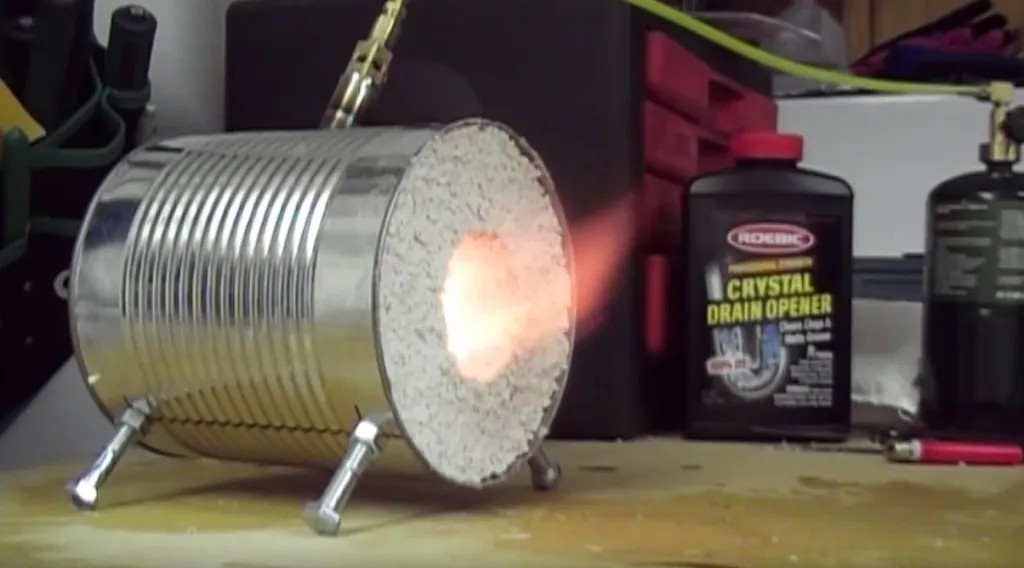 https://makezine.com/article/workshop/making-your-own-tin-can-forge/
https://makezine.com/article/workshop/making-your-own-tin-can-forge/
https://m.youtube.com/watch?v=xv9nnEhgfuY
I don't know that the design itself is actually applicable here, just that they're a good demonstration that even with a small forge, you can do some pretty cool blacksmithing.
In practice I think a solar forge would have to be open from the top, and couldn't really benefit from the tight space confining the heat, so it'd probably be closer to using a portable ferrier's anvil like you might see reenactors use at the fair, or something like this:
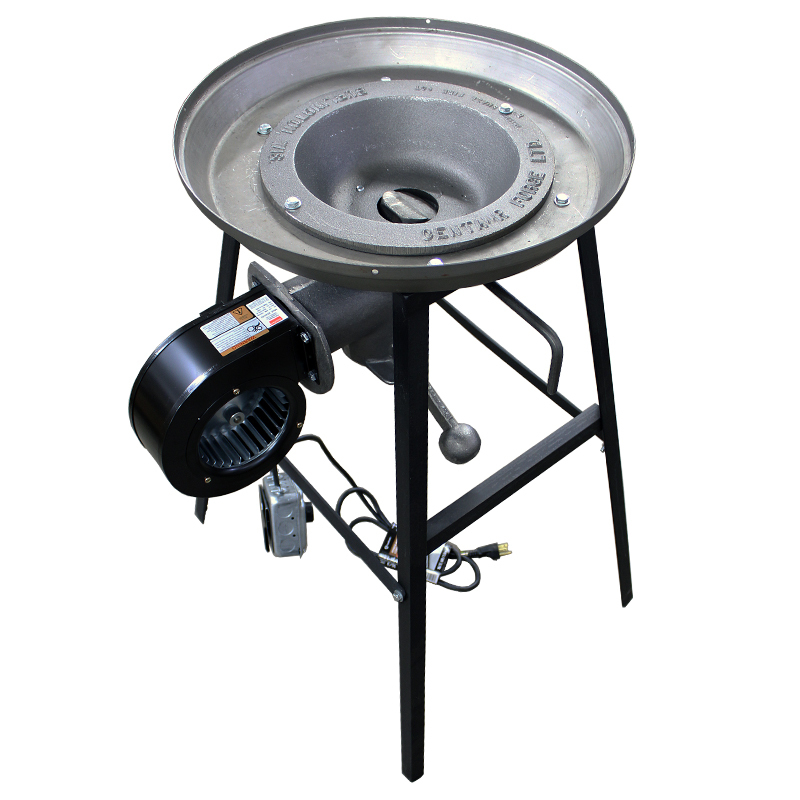
Though it'd look more like that artist's smelting rig with the big lens and all.
Thanks! I'm really excited to see what you come up with
 JacobCoffinWrites
2w ago
•
100%
JacobCoffinWrites
2w ago
•
100%
That's great! I don't have specific dimensions in mind (only because I haven't sourced a lens yet). I'm not sure about the beam width. I think no matter what, it'll be a narrower heat than you normally get with a coal fire or propane forge, so the blacksmith would probably have to adjust beam and shift the position of the piece to distribute the heat. But people make all kinds of things using little coffee can forges so if it allows for even that scale of project it'd be very useful.
It might not be a drop-in replacement for a traditional forge, but it could be a really cool way to preserve a lot of the practice without burning coal or gas. Let me know if I can help at all!
 JacobCoffinWrites
3w ago
•
100%
JacobCoffinWrites
3w ago
•
100%
So I'm not sure this would qualify, it may be too simple. I'd been thinking about trying to build a solar forge (I got to learn forging from a really good blacksmith who worked with coal for a couple years, though I am very much an amateur). I've seen videos of people using old fresnel lenses from rear projection TVs to burn through skillsaw blades and if you can melt steel, you can certainly forge it. It might just be slow, or too focused on one spot, requiring some movement to distribute the heat, something I'd have to mess with. It'd also be a bit of a safety hazard overall, but at least it'd be outside on a paved driveway instead of of inside a shed like my old coal forge.
I was picturing something similar to this smelter but with a reused TV lens, and a fire pot where his crucible is. The mechanical parts would be for rotating it to keep the sun shining through the lens, and possibly for adjusting the focus. Stability and safety would be a big consideration, don't want the wind blowing it around too much.
Again, not sure if it's what you're looking for, but I'd like you to get some usable answers here. Best of luck with your project, thank you for reaching out to involve the community!
 JacobCoffinWrites
4w ago
•
100%
JacobCoffinWrites
4w ago
•
100%
Thanks so much, that's great to hear! And thanks for all your input! Sorry the text is small, I work on a knockoff wacom-style tablet so I get used to looking at it zoomed in and from pretty close to the screen.
Feel free to post it anywhere, I'm always delighted to find out when these images travel around a bit on their own.
 JacobCoffinWrites
4w ago
•
100%
JacobCoffinWrites
4w ago
•
100%
Thanks so much! This was a fun one, I always loved these kind of diagrams/wimmelbilder type pictures and had a lot of fun trying to make one.

This is a little different from my other photobashes in that this one can’t really pass as a postcard. I ended up having so many things to include in the topic of flood-compatible cities that the only way to fit them all was to keep expanding the canvas. I think I have enough for a second picture (and possibly a third), but we’ll get to what’s missing in a moment. So awhile back, I stumbled on to [this discussion](https://www.reddit.com/r/solarpunk/comments/1f15h7a/iso_swampy_solarpunk_brainstorm/) on reddit about what solarpunk might look like in a wetland area (and what it'd mean for cities built in wetlands). I very much believe that solarpunk will look radically different based on location, with infrastructure, routines, fashion, etc, being carefully tailored to fit climate, local weather, and the available materials, so this really caught my attention. That discussion lead to [this one](https://slrpnk.net/post/12735795), and [this one](https://slrpnk.net/post/12769234), then [this one](https://slrpnk.net/post/13230132) as well as [this conversation back over there](https://www.reddit.com/r/solarpunk/comments/1fej443/looking_for_helpfeedback_with_art_of_a/) plus several good chats on the Fully Automated and Solarpunk Hub discords. I received a ton of awesome input which I genuinely couldn’t have made this without. Thank you! Most of the ideas here came from those talks. Even when people disagreed with each others’ suggestions, I tried to include them in the scene if I could make them fit. The basic idea is for this to be a city that expects to be flooded regularly. One where, if the water rises a few feet seasonally, everything stays basically the same, and if a huge storm rolls in and swamps the whole area, people grumble about it, but can mostly still go about their day (using things like elevated walkways). The lower portions of buildings are used for third place activities that can be packed up and removed when forecasts predict bad weather (like marketplaces) or which use sturdy, permanent structures which can be hosed clean later. There’s an argument to be made that the best answer to building cities in swamps is the simplest: don’t do it. And if you’ve failed that step, then you shouldn’t rebuild when whatever you build inevitably gets flooded. I think there’s a lot of reasons to push back on that. Most major cities are already built on waterways or on the coasts due to the value of those locations for shipping and industry. Some are already below seal level, others are likely to be in the future as climate change worsens. These places house millions of people, they represent home, historical legacies, and preserving them helps preserve the cultures and communities of the people who live there. Lots of cities are looking for answers to rising water, and I’d love to see what solarpunk versions look like. Sponge city tactics came up a lot in our discussions but we struggled to find ones that fit for a city (like New Orleans) which are at least partially located below sea level. If I expand the image to the left, I think I can definitely include a few, but generally, the water needs somewhere to go. That said, I think this scene fits a tight shot of a much larger take on sponge city tactics of slowing water and absorbing it where possible. Our current society has spent a lot of resources on straightening rivers for shipping and building dams and levees to shunt extra water downstream, to make it the next town’s problem, rather than suffer floods themselves. Farmers don’t want their fields washed out or polluted with debris so they build more levees and so on and so forth. I think a solarpunk civilization might accept on some level that rivers are going to meander, they’re going to rise seasonally, and they’re going to flood the flood plains they’ve always washed over, and it might build with those expectations in mind. A solarpunk setting might adjust itself to coexist with the weather and floods rather than use huge infrastructure projects to try to keep them away. The admittedly thin backstory I’ve got in mind is that this was a city which frequently flooded, and where some of its lowest areas (possibly mostly abandoned already due to uninsured damages and unlivable conditions near the collapse) were ceded to the water but not surrendered altogether. People built some structures higher than the water is likely to reach, and everywhere else, they float on it in boats, float houses, or even large rafts which contain small neighborhoods. They farm locally using floating gardens, hydroponics, Chinampas, and more. This isn’t a pristine wetland that’s been colonized, but a flooded neighborhood which has been partially rewilded. I pulled in a few different living-with-water concepts in for this one: * The lifted buildings are an upscaled version of the lifted houses you can find all along the US Gulf Coast, intended to survive storm surges and floods during hurricanes. * I based the covered upper walkway on the iron lace balconies found on some buildings in the New Orleans French Quarter. It’s not quite the ‘correct’ use of the design, since they don’t traditionally span from building to building, but I thought it’d be a nice reference. The goal here is that if the area really floods, and the ground level is unsafe to traverse, people still have a way to get around. For safety purposes, I figure each building needs a ladder on each road to access the upper level in an emergency. For accessibility, I included frequent, standardized elevators and 15 degree ramps. * I used [this amphibious bus design](https://camillc.com/hydraterra/) because it looked more municipal than the DUKW style duckboats many cities have for recreational purposes. Credit to Cromlyngames for suggesting this idea (and then making [this 3d model about it](https://www.thingiverse.com/thing:6744397)). I suspect the amphibious design would be harder to maintain than a normal bus because of the sealed hull, but perhaps some of the efficiencies and practice that come with a larger, standardized fleet would help. * Dutch-style floating houses (these exist all over the world but I referenced dutch ones while making this scene). These are just meant to be towed into place and parked. Unlike the houseboats which are more boat than house and can travel as they want. * A Bangkok-style water bus – the idea is that the flooded zone is likely somewhat shallow, with deeper waterways intended for transit between neighborhoods of floating houses, large rafts supporting small neighborhoods, and through rivers and canals in the dryer parts of the city. If I do another scene, I’ll try to include a transfer station where passengers can switch between boat and an elevated train. * Waterways with restored eelgrass for manatees. I wanted to show some of the work that’s been done restoring rivers in the US south. * [Chinampa agricultural system](https://en.wikipedia.org/wiki/Chinampa) (farming on artificial islands) this is a pretty ancient farming practice from Mexico and Central America, which is still in use in some areas, and I’m still learning about it. I’ve done my best to get the scale and composition of the design correct. Some of the trees might be a bit overlarge, but they wouldn’t be planted very densely. Other notes/elements included: * There’s a Savonius wind turbine attached to one of the dolphins (poles) for the dock. I imagine this probably isn’t supposed to be there, since it could get in the way during a high flood, but perhaps there’s not much enforcement or its the subject of a disagreement. * Awnings and porches to shade windows and balconies and buildings. The simple solutions work. * The hospital in the background would need to be able to operate during a flood, and to have water access (possibly via canals) so that people with only boats can access it quickly, in addition to road access. * The climbing wall probably isn’t ideal, as you’d want open spaces between the pillars if the flood will have a current. This was kind of an art decision - I needed a type of tall, narrow third place to include that would demonstrate its use even with the bus in the way and that seemed like the best option I could think of. Climbing walls are often made with wood frames and plywood – this one would have to be able to survive submersion, so perhaps it’s made from thick sections of recycled plastic or something similar. My other plan was just some trees, to show that it was a park, but that wasn’t as clear. Speaking of third places, here’s some other ideas we had for third places you could have under these buildings. Presented in no particular order: * Tide pools and natural landscape features * Parks * Dog Parks * Meeting rooms * Lecture spots (could double as a bring-your-own-movie movie theater) * Squash courts * Playground (depending on the design) * Planetarium? * Speaker’s corners * Booths for food trucks or downstairs seating for a lifted cafeteria * Parkour course * Roller rink * Laser tag/paintball arena * Fresh water reserve tanks (firefighting, heat sinks, municipal cleaning as well as last reserve drinking water post major floods * Possibly storage for flood-tolerant stuff like scaffolding Things I’d like to include next time: * Floating neighborhoods in the style of the floating islands of the Uros on Lake Titicaca (this would take a fair bit of space and a lot more reading) * A transfer station where passengers can switch between boat and an elevated train * Amphibious emergency vehicles This image, like all the [Postcards from a Solarpunk Future](https://jacobcoffinwrites.wordpress.com/postcards-from-a-solarpunk-future/), is CC-BY, use it how you like.

I used to walk past abandoned trucks out in the woods, so I wanted to capture something of that. The M9 Armored Combat Earthmover looks super cyberpunk to me, probably because it dates back to the 1980s, still in use. My inner Gibson fan wanted to include some kind of rusting, surplus military equipment in this rural cyberpunk comic, possibly a hovercraft. But I figure this fits the superfund site backstory nicely, since it’s supposedly rated for protection against chemical and biological agents. Also, like most military vehicles, the M9 has a cult fan following, making it pretty easy to find photos from a variety of angles, along with photos of model kits, which in this format are just as good. I have a (headcannon-only, at the moment) idea that these machines were upgraded a third time to house AI pilots on a similar level, perhaps a bit smarter, than the bodyguard. And that they might have been left with the chassis when the work was paused, then delayed and delayed, until they finally gave up on remediating the site. One possible resolution for the story might involve the bodyguard making friends with one, who is able to contact a human tech (a former site volunteer) who lives nearby and maintains the abandoned AIs as best he can. He might end up serving as a mediator between the robot and the outside world. You probably shouldn't tap the trees in a superfund site for sap, but that feels like a fairly cyberpunk sort of resignation/indifference to circumstances. I know some folks who do sapping IRL and they say animals often try to get into it – cows in particular are very clever with disconnecting hoses and such to get access to the delicious sugar water. They didn’t have any stories about deer but I bet it’s happened. I've almost run through the backlog of art for this silly rural cyberpunk webcomic. I'm hoping to make a few more, but the schedule might get a little unreliable for a bit after page 25. If want to read the rest of it you can find it here: https://jacobcoffinwrites.wordpress.com/president-deer-adventures/ If you’d like to read the related-but-mutually-non-canonical short story version, you can find it here: https://en.scrappycapydistro.info/harbour it’s in the first edition, on page 3!

Hi, I just wanted to say thanks for all your help on [my previous question](https://slrpnk.net/post/12769234) planning art of a more flood-compatible city! I've tried to include everyone's suggestions from last time, plus everything from [here](https://slrpnk.net/post/12735795), and discussions on reddit and discord. I don't plan to clutter up the community with any drafts after this one, but I was hoping to get one more pass with my current sketch since its based mostly on your ideas. Is there anything you'd like to see added or changed in a depiction of a city that's built to flood? Thanks again!
cross-posted from: https://slrpnk.net/post/13032570 > One of my ongoing goals is to emphasize reuse in solarpunk media – both through [my own projects](https://jacobcoffinwrites.wordpress.com/postcards-from-a-solarpunk-future/) and whenever I get the chance while helping others through suggestions or editing. > > There’s a wealth of *stuff* all around us which could be repurposed in creative ways, and solarpunk art and fiction has a wonderful opportunity to demonstrate that ingenuity and thrift. > > A lot of that stuff is in cars. So here’s some notes I’ve pulled together from various online discussions and from many people’s recommendations in solarpunk spaces. It’s not exhaustive, its probably not all good advice, but it should be good enough for a writer to casually drop into a description of a room or workshop, or for an artist to include in the background of a scene. Something that shows that this isn’t a scratch-built future, that they’re repurposing existing stuff wherever they can. > > Think of all the weird ways postapoclyptic movies dress the sets with misused items from the present – here’s a somewhat practical guide to solarpunk set dressing with the guts of cars: > > The big stuff: > > * Depending on the vehicle, its frame (if it has one), axles, and wheels can be used to make a trailer, cart, or similar. (I’ve definitely seen trailers that were just the back half of a pickup truck with a tongue and hitch welded on.) Bonus: the bearings in car wheels tend to be better than those used in regular trailers. > * The transmission from a vehicle could be rigged up to a wind/water mill to adjust rotational velocity of a sawmill or other industrial application. Some power tools, like lathes, use vehicle transmissions: [https://www.practicalmachinist.com/forum/threads/truck-transmission-for-lathe.240574/](https://www.practicalmachinist.com/forum/threads/truck-transmission-for-lathe.240574/) > * Steel leaf springs can be removed from their bundles (they’re long, flat pieces of steel stacked and bound together with strips of steel) and are favorites of blacksmiths for making swords and knives because of the type of steel used. > * Earthships can be made with stacked tires packed with rammed earth: [https://earthship.com/systems/garbage-management/](https://earthship.com/systems/garbage-management/) > > The Electronics: > > * Alternators can be [used](https://www.city-data.com/forum/self-sufficiency-preparedness/1911960-water-wheel-alternator.html) [to](https://permies.com/t/55706/power-home-alternator) [generate](https://www.4x4community.co.za/forum/showthread.php/260128-Water-Wheel-Alternator-power/page2) a wide range of amperage and voltage, suitable for different needs, including (in a few specific cases) welding: https://diysolarforum.com/threads/diy-low-cost-generator-from-vehicle-alternator-alternating-generator.1843/ > * The terminology here is a little confusing – early cars had DC generators (sometimes called dynamos), then they switched to AC alternators. But modern ’emergency generators’ still use alternators hooked up to an engine. So if you’re looking for something to convert motion to electricity, perhaps to attach to a water wheel, a vehicle alternator (and some belts to adjust the speeds) could do the job. > * Some caveats: suitable vehicle generators and [motors](https://www.mdpub.com/Wind_Turbine/) will likely work better, and to get an alternator to work you may need to either include a power source of 12v to excite the alternator, or to to replace certain internals to include permanent magnets. You'll need to mess with the gear/pulley ratio to get the right (high) speed too. > * The electronics in most cars are usually all designed to run off 12 volts, which can be very convenient for a household with solar panels depending on their setup. If a household has a low-voltage DC battery bank (some do, some don’t) then dropping the battery voltage a few times to power car parts comes with a smaller efficiency loss. > * These 12 volt electronics include things like the cab lights, headlights, radio/entertainment system, backup/surround cameras (perhaps for a security system?), all of which could be placed in a home on a circuit providing the same power they’d get in a car. > * LED headlights make for decent grow lights. Different models hit different parts of the spectrum, but generally they’re sturdy, run cool, and don’t take much power. They might not be as fine-tuned for plants as a dedicated product but they’re common and probably not being used for much in a solarpunk society. > * Alternative use: outdoor lights, indoor spotlights, light on a wagon, rickshaw etc. > * A car air conditioner could cool some small storage room decently. With big living rooms, it would have difficulty [https://permies.com/t/177638/Convert-car-air-conditioner-home](https://permies.com/t/177638/Convert-car-air-conditioner-home) > * Cars have lots of small electric motors with various advantages and disadvantages: you can pull motors from the blower, power windows, and windshield wiper motors have a fair bit of torque and can be decent actuators for some projects (I’ve seen them included in robotics projects). > * The blower and motor could be used for ventilation elsewhere. > * Starter motors are tricky – they’re designed to provide a lot of sudden torque to briefly turn the engine, and not to run for a long time. So they don’t fit a lot of our usual use-cases for electric motors. I’ve seen forum posts that describe using them for hoists (like to lift heavy things) but that’s about it so far. > * There’s plenty of wiring in a car which can all be reused as long as the gauge is correct for the new use. > * [Automotive Relays](https://m.youtube.com/watch?v=fdj_g_1tj4c&pp=ygUVc2VjcmV0IGxpZmUgb2YgcmVsYXlz) are used to enable a low amperage circuit to switch a higher amperage circuit on or off, making the control systems safer. One example given was switching on heaters in a thermal storage water tank. There’s a fair number of forum threads where people link arduinos to automotive relays to control things the arduino couldn’t handle on its own. > * Car batteries have long seen alternative uses – they might be the one car part used most outside of cars. As vehicles go hybrid and electric, their bigger, more powerful batteries become more common. Even when they weaken overtime, the lower power density doesn’t matter much for fixed installations where weight isn’t a factor, so old electric car batteries show up in homes and local grid storage systems: [https://www.motherjones.com/environment/2023/11/old-ev-batteries-solar-power-grid-backup-b2u/](https://www.motherjones.com/environment/2023/11/old-ev-batteries-solar-power-grid-backup-b2u/) > > Moving fluids: > > * Various pumps and tubing can be used for moving fluids (though the original purpose/contents will restrict what you can use them for). > * The tubing, tanks, pumps, and other parts used for windshield washer fluid are probably the safest car-fluid-handling components to reuse for non-car things (with a lot of rinsing and cleaning): https://www.mountainbuzz.com/threads/reusing-wiper-fluid-jugs-for-drinking-water.97053/ > * Possible uses could include aquariums and hydroponic setups (This may stand out to fish keepers though, who are *very* cautious around how they handle the water for their aquatic friends and who would be leery of traces of methyl alcohol wiper fluid contaminating it. https://www.nano-reef.com/forums/topic/376583-windshield-wiper-water-pump-as-ato-pump/) > * Car radiators work well for heat exchange, their intended purpose whether they’re in a car or not. This can be part of systems for heating or cooling. > * Copper brake line can also be used in heat exchanges. > * Fuel and brake lines should definitely not be used for things like potable water. But you wouldn’t be using potable water for heat exchange anyways, so contamination from the radiators, tubing, or brake line won’t make much difference there. > > Odds and Ends: > > * Inside the rubber squeegee part of windshield wipers is a long thin strip of good quality spring steel. Lockpicking folks like it for making tools. > * Catalytic converters might be useful for other kinds of filtering? Maybe not in wood stoves though: [https://permies.com/t/96864/Misusing-car-parts-cleaner-cooking](https://permies.com/t/96864/Misusing-car-parts-cleaner-cooking) > * Certain vehicle exhaust parts can be used to make [rocket stoves](https://permacultureprinciples.com/post/rocket-stoves/): https://permies.com/t/15611/Auto-exhaust-muffler-pipe-parts > * [https://permies.com/t/129517/Homemade-Wood-Stove-Propane-Tank](https://permies.com/t/129517/Homemade-Wood-Stove-Propane-Tank) > > Cosmetic stuff: > > * Seats: couches, chairs, porch swing, etc, fabric, foam stuffing for stuffed animals. > * Windows are tricky because the shapes are weird, which can make framing them difficult, but they could be set into clay or concrete or similar building materials. > * Hoods, roofs, and body panels offer some large sheets of metal which could be used for sheds. > > Last but not least, there’s always conversion to run on [woodgas ](https://solar.lowtechmagazine.com/2010/01/wood-gas-vehicles-firewood-in-the-fuel-tank/)(something I’ve [depicted in a photobash](https://jacobcoffinwrites.wordpress.com/2024/01/03/woodgas-plow-truck-filling-a-village-snow-vault/)) for some limited uses, or [conversion](https://fortune.com/2022/12/25/convert-vintage-classic-muscle-cars-into-electric-vehicles-ev/) to [electric](https://www.swtimes.com/story/special/2019/11/17/they-turn-old-hotrods-into/2270831007/). And if all else fails, you can always melt them down for your society’s steel manufacturing needs – electric arc furnace smelters running off a green grid, recycling, are about as close to zero emission steel as you’re likely to get, and the metal is already refined so I think you could get pretty tight control over the quality on the output. > > But I hope you’ll consider some of the above possibilities too. The parts are out there, we might as well use them. > > Thanks for reading! Like I said, this is by no means an exhaustive list, so if you know of something I’ve missed, or see something I got wrong, I’m happy to edit it! > > Also available here: [https://jacobcoffinwrites.wordpress.com/2024/09/04/using-every-part-of-the-car-a-resource-for-solarpunk-writers-and-artists/](https://jacobcoffinwrites.wordpress.com/2024/09/04/using-every-part-of-the-car-a-resource-for-solarpunk-writers-and-artists/)
One of my ongoing goals is to emphasize reuse in solarpunk media – both through [my own projects](https://jacobcoffinwrites.wordpress.com/postcards-from-a-solarpunk-future/) and whenever I get the chance while helping others through suggestions or editing. There’s a wealth of *stuff* all around us which could be repurposed in creative ways, and solarpunk art and fiction has a wonderful opportunity to demonstrate that ingenuity and thrift. A lot of that stuff is in cars. So here’s some notes I’ve pulled together from various online discussions and from many people’s recommendations in solarpunk spaces. It’s not exhaustive, its probably not all good advice, but it should be good enough for a writer to casually drop into a description of a room or workshop, or for an artist to include in the background of a scene. Something that shows that this isn’t a scratch-built future, that they’re repurposing existing stuff wherever they can. Think of all the weird ways postapoclyptic movies dress the sets with misused items from the present – here’s a somewhat practical guide to solarpunk set dressing with the guts of cars: The big stuff: * Depending on the vehicle, its frame (if it has one), axles, and wheels can be used to make a trailer, cart, or similar. (I’ve definitely seen trailers that were just the back half of a pickup truck with a tongue and hitch welded on.) Bonus: the bearings in car wheels tend to be better than those used in regular trailers. * The transmission from a vehicle could be rigged up to a wind/water mill to adjust rotational velocity of a sawmill or other industrial application. Some power tools, like lathes, use vehicle transmissions: [https://www.practicalmachinist.com/forum/threads/truck-transmission-for-lathe.240574/](https://www.practicalmachinist.com/forum/threads/truck-transmission-for-lathe.240574/) * Steel leaf springs can be removed from their bundles (they’re long, flat pieces of steel stacked and bound together with strips of steel) and are favorites of blacksmiths for making swords and knives because of the type of steel used. * Earthships can be made with stacked tires packed with rammed earth: [https://earthship.com/systems/garbage-management/](https://earthship.com/systems/garbage-management/) The Electronics: * Alternators can be [used](https://www.city-data.com/forum/self-sufficiency-preparedness/1911960-water-wheel-alternator.html) [to](https://permies.com/t/55706/power-home-alternator) [generate](https://www.4x4community.co.za/forum/showthread.php/260128-Water-Wheel-Alternator-power/page2) a wide range of amperage and voltage, suitable for different needs, including (in a few specific cases) welding: https://diysolarforum.com/threads/diy-low-cost-generator-from-vehicle-alternator-alternating-generator.1843/ * The terminology here is a little confusing – early cars had DC generators (sometimes called dynamos), then they switched to AC alternators. But modern ’emergency generators’ still use alternators hooked up to an engine. So if you’re looking for something to convert motion to electricity, perhaps to attach to a water wheel, a vehicle alternator (and some belts to adjust the speeds) could do the job. * Some caveats: suitable vehicle generators and [motors](https://www.mdpub.com/Wind_Turbine/) will likely work better, and to get an alternator to work you may need to either include a power source of 12v to excite the alternator, or to to replace certain internals to include permanent magnets. You'll need to mess with the gear/pulley ratio to get the right (high) speed too. * The electronics in most cars are usually all designed to run off 12 volts, which can be very convenient for a household with solar panels depending on their setup. If a household has a low-voltage DC battery bank (some do, some don’t) then dropping the battery voltage a few times to power car parts comes with a smaller efficiency loss. * These 12 volt electronics include things like the cab lights, headlights, radio/entertainment system, backup/surround cameras (perhaps for a security system?), all of which could be placed in a home on a circuit providing the same power they’d get in a car. * LED headlights make for decent grow lights. Different models hit different parts of the spectrum, but generally they’re sturdy, run cool, and don’t take much power. They might not be as fine-tuned for plants as a dedicated product but they’re common and probably not being used for much in a solarpunk society. * Alternative use: outdoor lights, indoor spotlights, light on a wagon, rickshaw etc. * A car air conditioner could cool some small storage room decently. With big living rooms, it would have difficulty [https://permies.com/t/177638/Convert-car-air-conditioner-home](https://permies.com/t/177638/Convert-car-air-conditioner-home) * Cars have lots of small electric motors with various advantages and disadvantages: you can pull motors from the blower, power windows, and windshield wiper motors have a fair bit of torque and can be decent actuators for some projects (I’ve seen them included in robotics projects). * The blower and motor could be used for ventilation elsewhere. * Starter motors are tricky – they’re designed to provide a lot of sudden torque to briefly turn the engine, and not to run for a long time. So they don’t fit a lot of our usual use-cases for electric motors. I’ve seen forum posts that describe using them for hoists (like to lift heavy things) but that’s about it so far. * There’s plenty of wiring in a car which can all be reused as long as the gauge is correct for the new use. * [Automotive Relays](https://m.youtube.com/watch?v=fdj_g_1tj4c&pp=ygUVc2VjcmV0IGxpZmUgb2YgcmVsYXlz) are used to enable a low amperage circuit to switch a higher amperage circuit on or off, making the control systems safer. One example given was switching on heaters in a thermal storage water tank. There’s a fair number of forum threads where people link arduinos to automotive relays to control things the arduino couldn’t handle on its own. * Car batteries have long seen alternative uses – they might be the one car part used most outside of cars. As vehicles go hybrid and electric, their bigger, more powerful batteries become more common. Even when they weaken overtime, the lower power density doesn’t matter much for fixed installations where weight isn’t a factor, so old electric car batteries show up in homes and local grid storage systems: [https://www.motherjones.com/environment/2023/11/old-ev-batteries-solar-power-grid-backup-b2u/](https://www.motherjones.com/environment/2023/11/old-ev-batteries-solar-power-grid-backup-b2u/) Moving fluids: * Various pumps and tubing can be used for moving fluids (though the original purpose/contents will restrict what you can use them for). * The tubing, tanks, pumps, and other parts used for windshield washer fluid are probably the safest car-fluid-handling components to reuse for non-car things (with a lot of rinsing and cleaning): https://www.mountainbuzz.com/threads/reusing-wiper-fluid-jugs-for-drinking-water.97053/ * Possible uses could include aquariums and hydroponic setups (This may stand out to fish keepers though, who are *very* cautious around how they handle the water for their aquatic friends and who would be leery of traces of methyl alcohol wiper fluid contaminating it. https://www.nano-reef.com/forums/topic/376583-windshield-wiper-water-pump-as-ato-pump/) * Car radiators work well for heat exchange, their intended purpose whether they’re in a car or not. This can be part of systems for heating or cooling. * Copper brake line can also be used in heat exchanges. * Fuel and brake lines should definitely not be used for things like potable water. But you wouldn’t be using potable water for heat exchange anyways, so contamination from the radiators, tubing, or brake line won’t make much difference there. Odds and Ends: * Inside the rubber squeegee part of windshield wipers is a long thin strip of good quality spring steel. Lockpicking folks like it for making tools. * Catalytic converters might be useful for other kinds of filtering? Maybe not in wood stoves though: [https://permies.com/t/96864/Misusing-car-parts-cleaner-cooking](https://permies.com/t/96864/Misusing-car-parts-cleaner-cooking) * Certain vehicle exhaust parts can be used to make [rocket stoves](https://permacultureprinciples.com/post/rocket-stoves/): https://permies.com/t/15611/Auto-exhaust-muffler-pipe-parts * [https://permies.com/t/129517/Homemade-Wood-Stove-Propane-Tank](https://permies.com/t/129517/Homemade-Wood-Stove-Propane-Tank) Cosmetic stuff: * Seats: couches, chairs, porch swing, etc, fabric, foam stuffing for stuffed animals. * Windows are tricky because the shapes are weird, which can make framing them difficult, but they could be set into clay or concrete or similar building materials. * Hoods, roofs, and body panels offer some large sheets of metal which could be used for sheds. Last but not least, there’s always conversion to run on [woodgas ](https://solar.lowtechmagazine.com/2010/01/wood-gas-vehicles-firewood-in-the-fuel-tank/)(something I’ve [depicted in a photobash](https://jacobcoffinwrites.wordpress.com/2024/01/03/woodgas-plow-truck-filling-a-village-snow-vault/)) for some limited uses, or [conversion](https://fortune.com/2022/12/25/convert-vintage-classic-muscle-cars-into-electric-vehicles-ev/) to [electric](https://www.swtimes.com/story/special/2019/11/17/they-turn-old-hotrods-into/2270831007/). And if all else fails, you can always melt them down for your society’s steel manufacturing needs – electric arc furnace smelters running off a green grid, recycling, are about as close to zero emission steel as you’re likely to get, and the metal is already refined so I think you could get pretty tight control over the quality on the output. But I hope you’ll consider some of the above possibilities too. The parts are out there, we might as well use them. Thanks for reading! Like I said, this is by no means an exhaustive list, so if you know of something I’ve missed, or see something I got wrong, I’m happy to edit it! Also available here: [https://jacobcoffinwrites.wordpress.com/2024/09/04/using-every-part-of-the-car-a-resource-for-solarpunk-writers-and-artists/](https://jacobcoffinwrites.wordpress.com/2024/09/04/using-every-part-of-the-car-a-resource-for-solarpunk-writers-and-artists/)
Hi, I've had some good discussions here in the past, so I thought I'd reach out with an idea for a resource I'd like to try to put together for solarpunk writers and artists. I was talking with A.E. Marling about a story he's working on, and one of the things he was looking for was uses for old cars. I think the obvious answer you'll get from solarpunks (aside for limited use where it makes sense) is to melt them down for your society's steel manufacturing needs - electric arc furnace smelters running off a green grid, recycling, are about as close to zero emission steel as you're likely to get, and the metal is already refined so I think you could get pretty tight control over the quality on the output. But I think reuse offers some much more interesting opportunities. I'm only just starting to learn about fixing cars, but I've already been struck by the fact that at least some parts in cars can go into other things. For example, it looks like certain old alternators can be used to generate a wide range of amperage and voltage, suitable for different needs, including welding: https://diysolarforum.com/threads/diy-low-cost-generator-from-vehicle-alternator-alternating-generator.1843/ so perhaps one could be hooked by belts (adjusting speed) to a waterwheel or something? I feel like a solarpunk society with a really strong library economy might start cataloguing parts of more complicated machines (even salvaged from machines like cars). And looking for parts commonalities and alternative uses strikes me as a really cool step towards building an open-source manufacturing sphere. Perhaps starting with a database of hardware/parts so they could be identified and repurposed, and alternatives identified. So the actual proposal: I'd like to try and put together a list of common car parts which can be reasonably used in other (more solarpunk) contexts. This doesn't have to be specific down to the model number or include a how-to guide, (though I recognize that some reuses might only be possible with a specific model) just something solarpunk writers could casually drop into a description of a room or workshop, or an artist could put in the background of a scene. Something that shows that this isn't a scratch-built future, but that they're repurposing stuff where they can. Think of all the weird ways postapoclyptic movies dress the sets with misused items from the present - we could offer something like that to solarpunk, but grounded in at least some practicality. If you have any suggestions, I'd love to hear them. Thanks! edit: I've built out a list and it's located over here: https://slrpnk.net/post/13032570

I've been thinking about trying to depict some of the ideas from this conversation: https://slrpnk.net/post/12735795, using a sort of flat, diagram-like style similar to this old photobash:  Though a bit more complex. The obvious answer is 'don't build cities in swamps' but we already have a bunch of them, and though I don't live there I recognize that they have a lot of unique cultural and historical value and are peoples' homes, so I'm interested in what a solarpunk-adapted version of these would look like. At the same time, I know basically nothing about New Orleans or similar areas, have no background in civil engineering, and no qualifications to make this except for the capability to do so using an old version of GIMP. So I'd absolutely love to identify issues, places to make improvements, and things that are missing now rather than once I've spent days chopping up images and finessing them into something coherent. So what'd I get wrong? What's unworkable, out of scale, or dangerous? What style of buildings or cultural touchstones would you like to see? What kind of plants are missing?
 movim.slrpnk.net
movim.slrpnk.net
This is basically my most traditional bookbinding project. I used regular fabric cloth for the cover, and followed the traditional steps. The interesting (to me) change is the use of a CO2 laser cutter to mark the fabric. Here's the steps to making it: 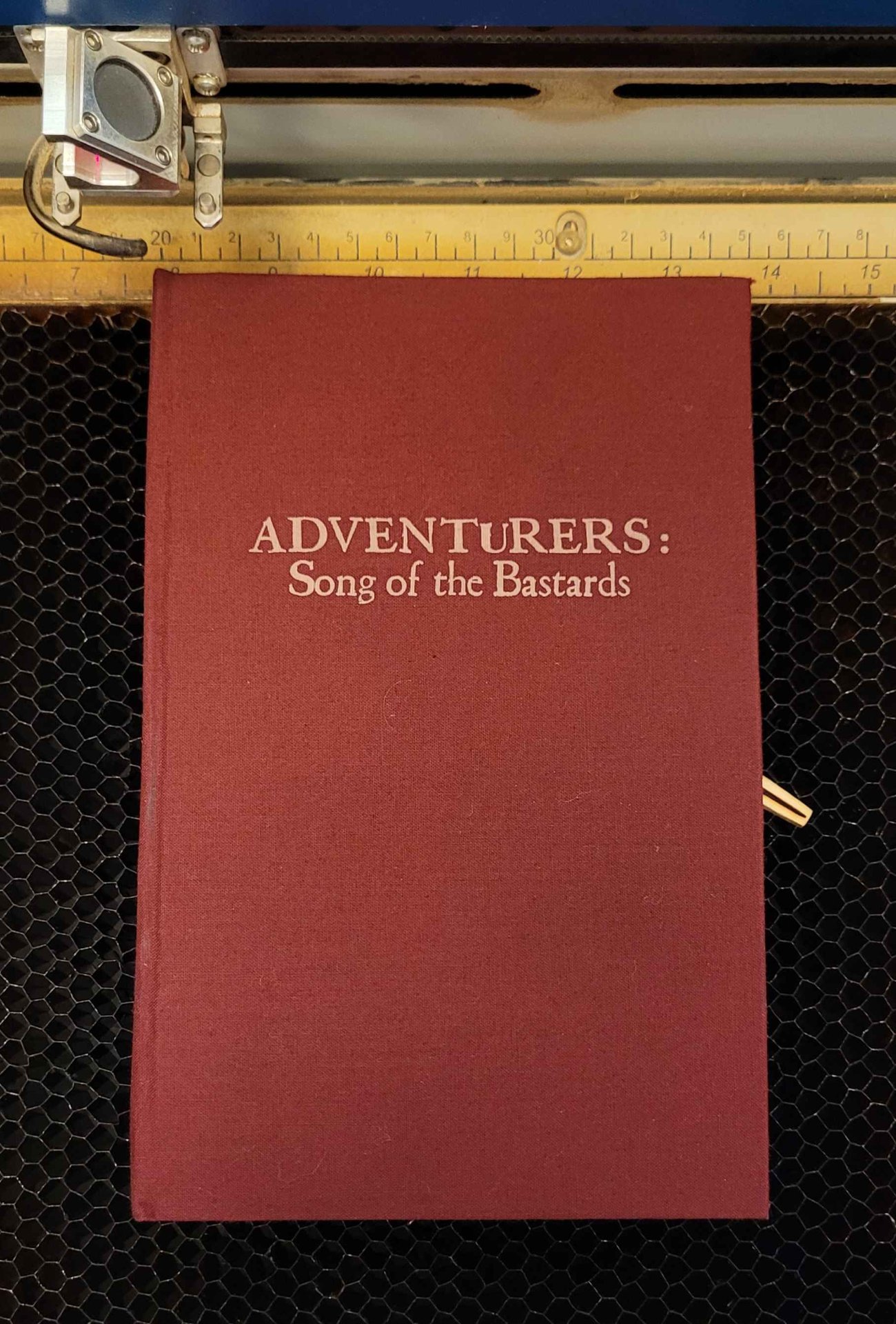 I think it's fair to say that this book is extremely rare. The author has told me that the one physical copy I've made is the only one in the world, aside from an 'ugly stapled proof [he has] in a drawer somewhere.' The book was released on patreon as serialized fiction, with each of the six sections being made available as early drafts to a certain tier. The plan was that he'd put them up briefly, take them down again, then compile the drafts and eventually release a full published version. For life-happened reasons, the last step never got done (though the author was kind enough to repost the six sections on a discord channel when I asked). Just the same, it was one of my all-time favorite stories, so if it wasn't likely to end up somewhere I could buy it, I was at least going to make a copy of my own. So I took the six pdfs and started editing them using whichever online tools seemed like they'd do the best job. I started by cropping the files so they'd fit the correct aspect ratio for 8.5x11" letter paper folded in half, but started getting fancier as I went. I removed pages of bonus content from the back of each one so it'd flow better as a book. I merged them all together into one file (to reduce the number of mid-book blank pages from turning it into folio signatures). I even added a second set of page numbers to the bottom because the ones in the top right restarted in every section. I manually added some blank pages front and back. By the time I was done, I had something to feed into [https://momijizukamori.github.io/bookbinder-js/](https://momijizukamori.github.io/bookbinder-js/) I used that to create letter page folio signatures (with sets of 4 and 3 pages per signature). Now I had something I could actually print. We did so on a regular office photocoppier, and I can't recommend printing each signature separately and organizing them with paperclips enough. I would have lost my mind trying to sort them otherwise). We start off the actual bookbinding in a pretty familiar way, taking each signature, folding each page of it in half with the bone folder, nesting them, and adding that signature to the stack. 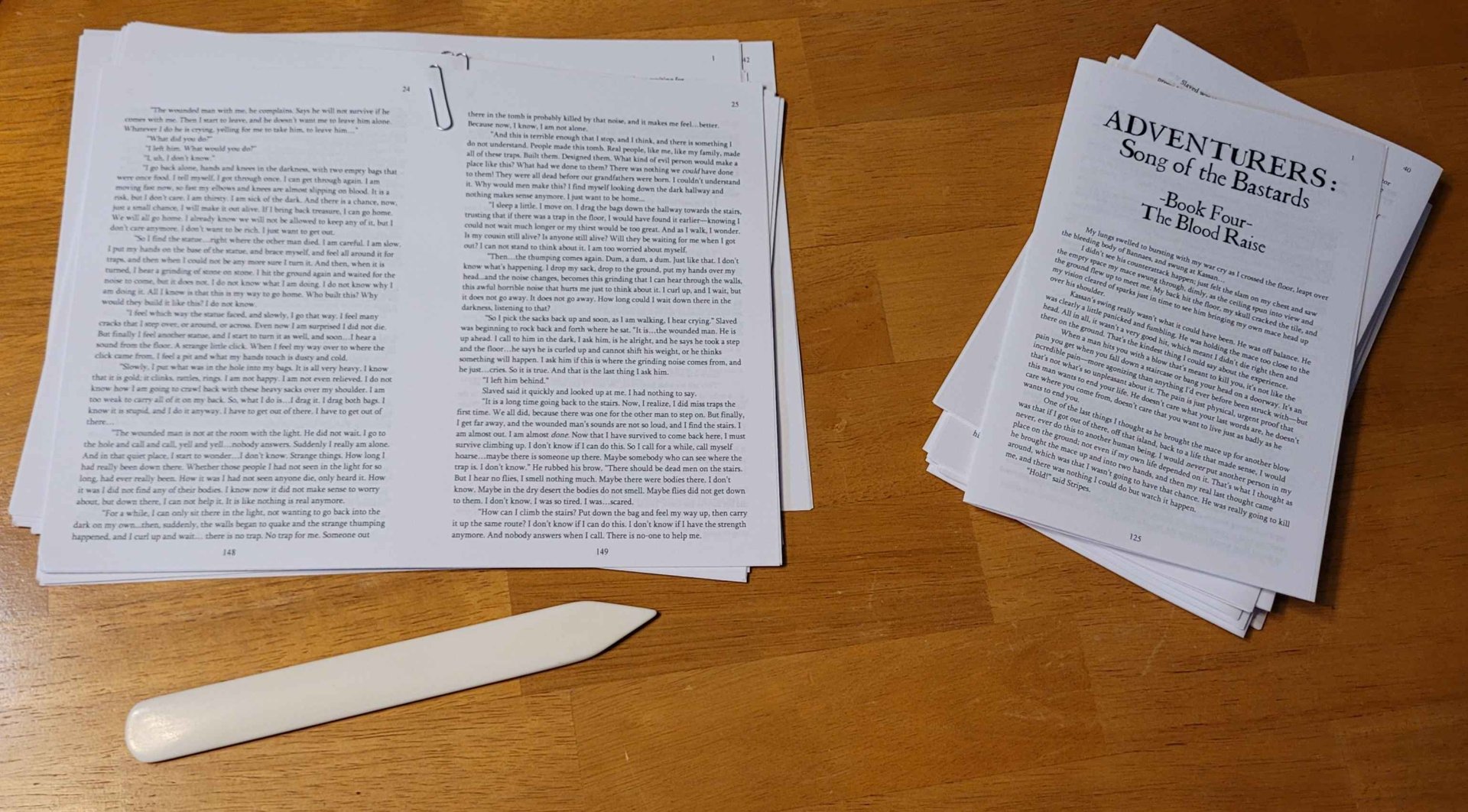 Then I used my template from the previous bookbinding project to punch holes through each signature. One really nice thing about not having to trim whitespace from my pages is that the overall page size (and thus most dimensions of the cover except the spine) will remain the same no matter what is printed on the page or which printer I use. So I can reuse things like this template. 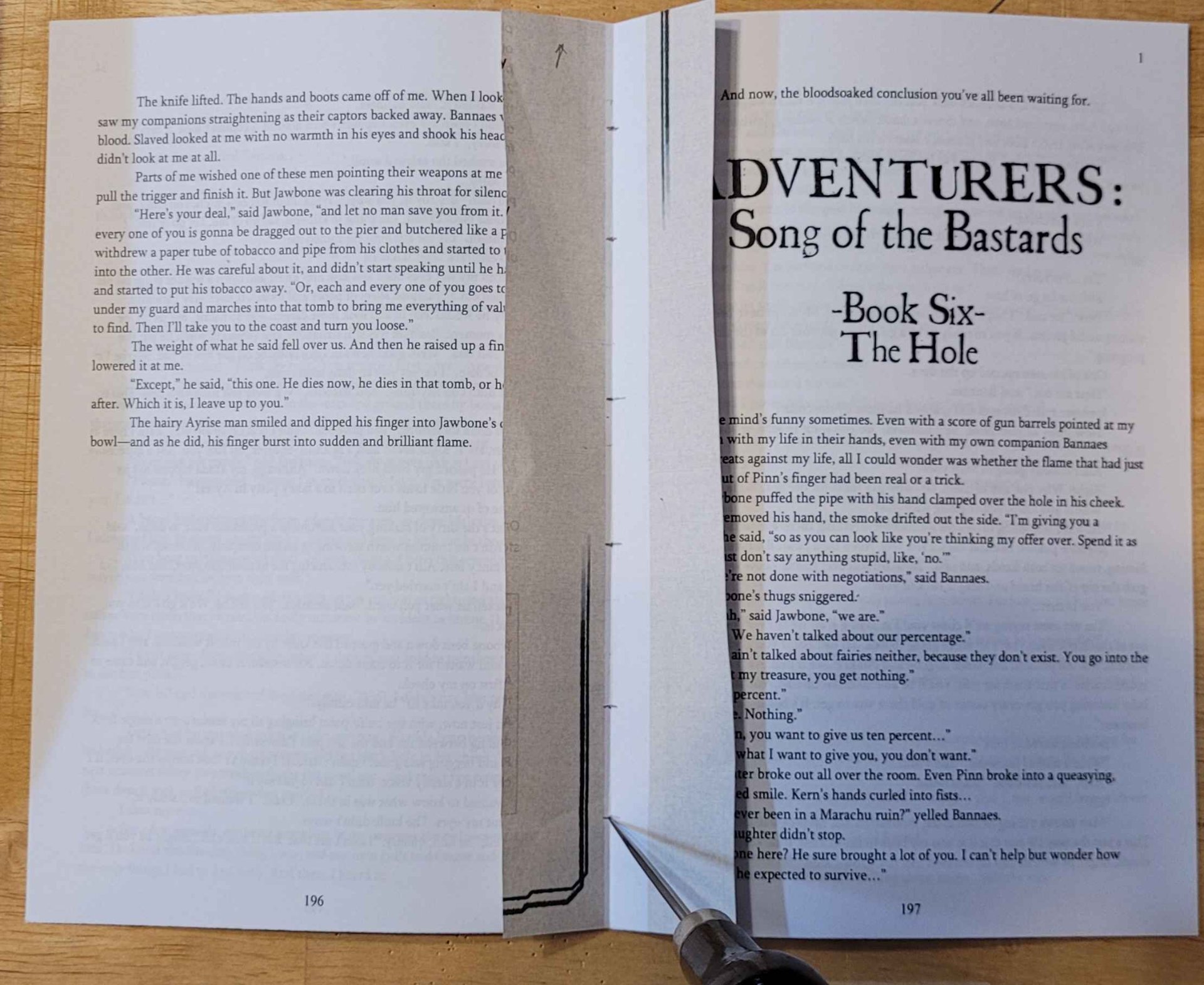 Here's my template with its measurements in case you want to reference it: 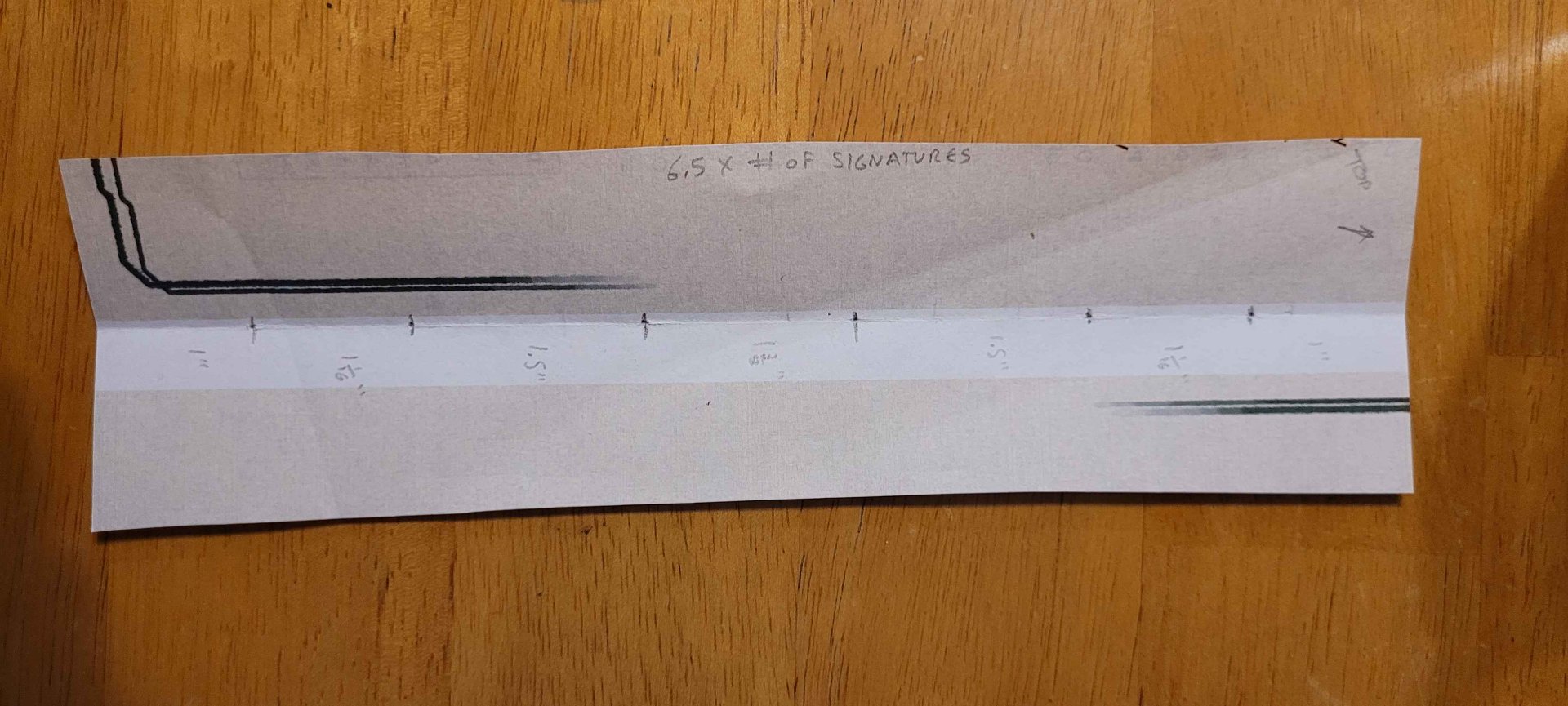 Eventually this left a nice stack of signatures ready to sew together: 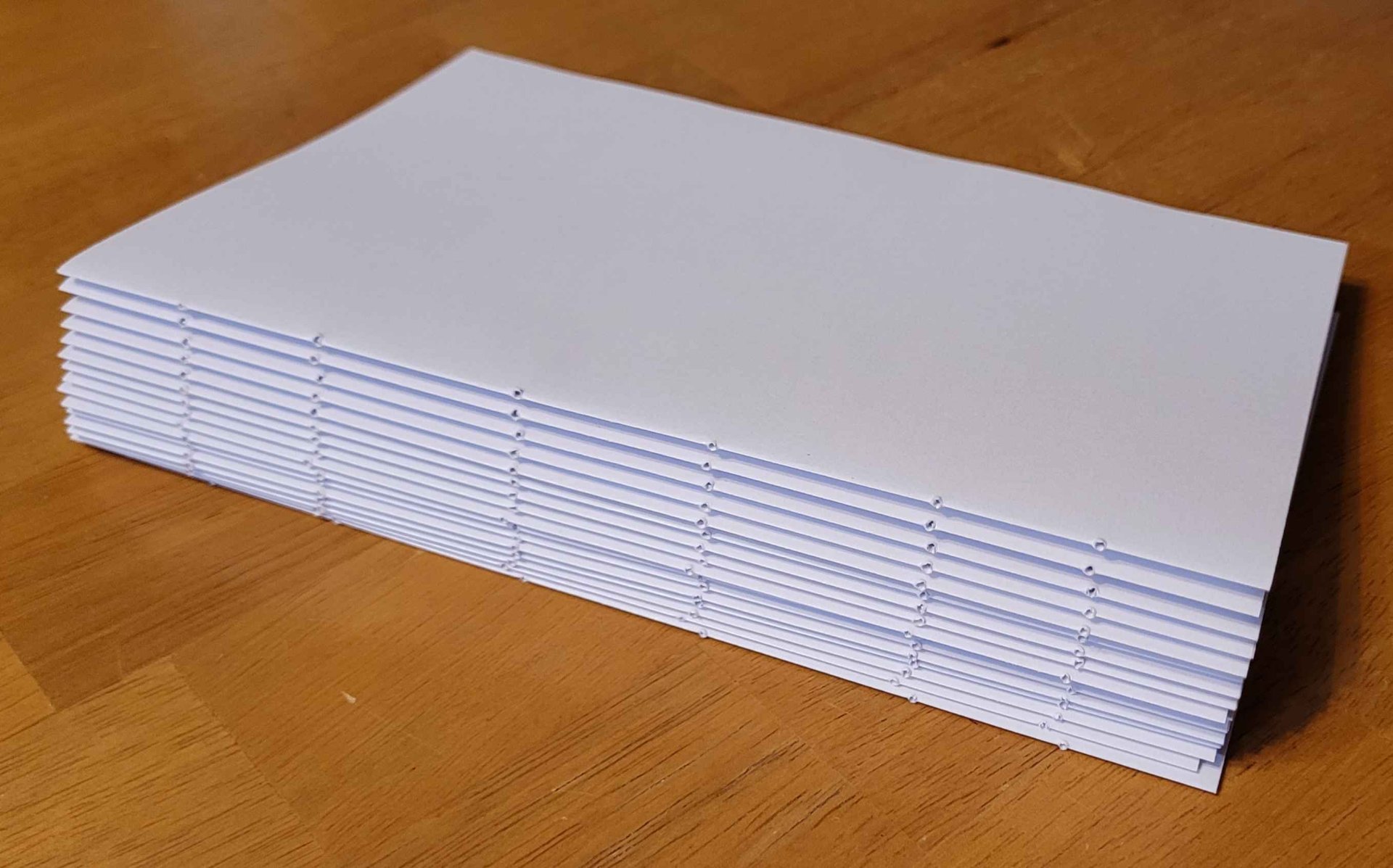 As before, I sewed it together using waxed thread, following the [Penrose Press Pretty Perfect Paperback Guide](https://www.penrosepress.ca/blogs/nerd-time/nerd-time-with-brianna-pretty-perfect-paperback-binding). I know there are a bunch of ways to do this, but I quite like this technique.  The next step is to clamp and glue the bookblock together. My clamp is pretty crude, it's just a 2x4' screwed to a piece of particleboard, with a couple ragged sheets of wax paper keeping the book from gluing to the clamp. The goal is to get it as tightly pressed as possible while keeping the book block nice and square. I didn't take a picture of this step for this project, so here's one from the last book. Note how the signatures are jumbled along the edge. I've gotten much better about lining them up recently. 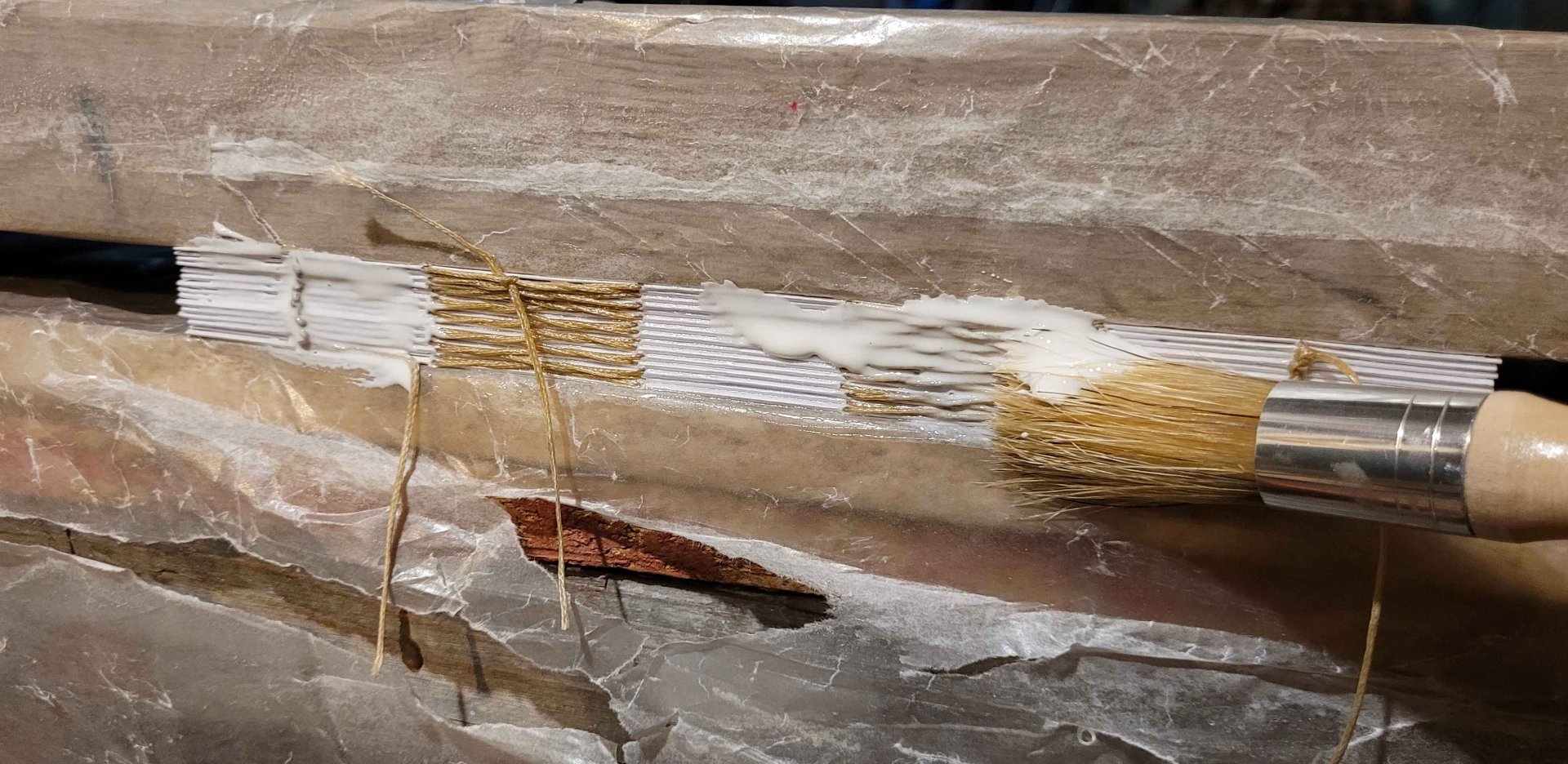 I usually use my finger to work the glue into the gaps these days, it's faster and makes less mess than the brush. I think it gets into the gaps better too. I do three coats of glue on the spine. For hardcovers like this one, I then glue on a strip of mull or cheesecloth which is a couple inches wider than the spine on either side (front to back), and like an inch or so shorter than the top of the spine (heightwise). Then I glue on a strip of watercolor paper (it's supposed to be manila paper but I don't have that). 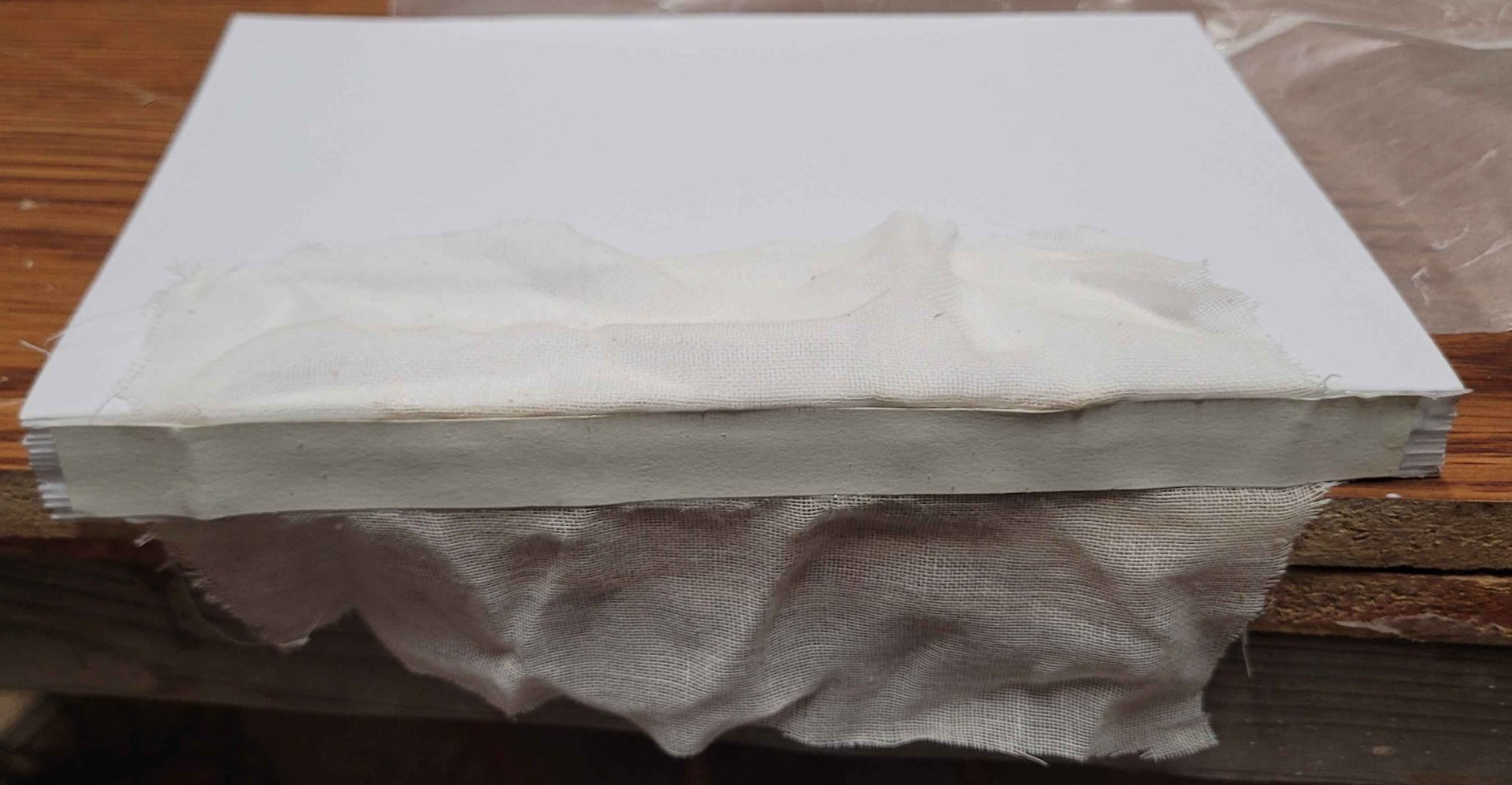 Now it's time to start on the actual cover. I size the bookboard so it'll overlap the book block by 3mm on the top, bottom, and open edge. You're supposed to make it 3mm wider for that overhang, but then remove 6mm for the hinge by the spine (so that's actually -3mm) but I haven't had good luck with that, the open edge always seemed too close to the book block, so I just leave it the same width as the book block and slide it out 6mm. Somehow that works. 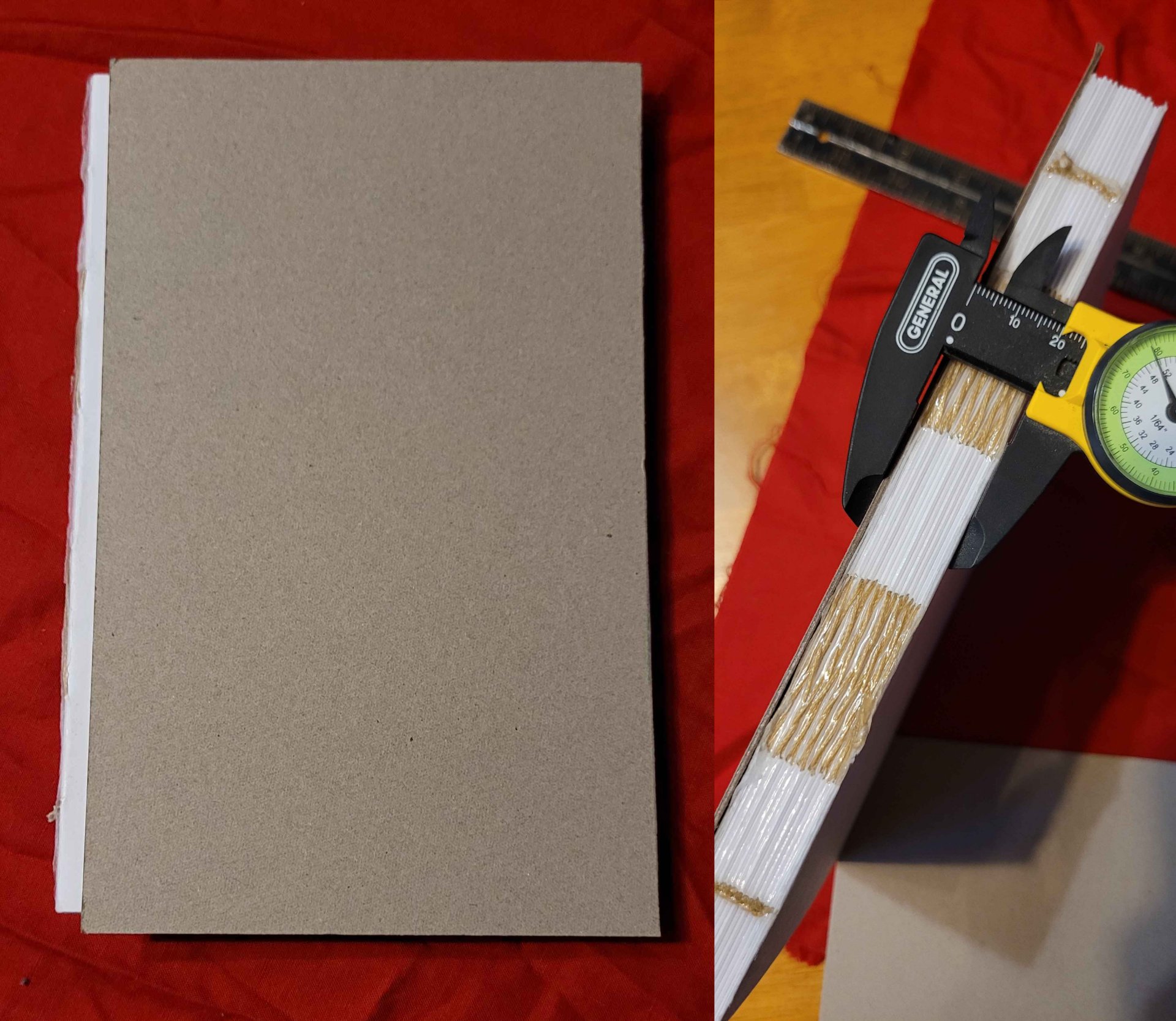 To get the spine width, you're supposed to measure the spine of the book plus one thickness of bookboard, but my spines often come out a bit thicker than the rest of the book so I'm sure about that guidance either. 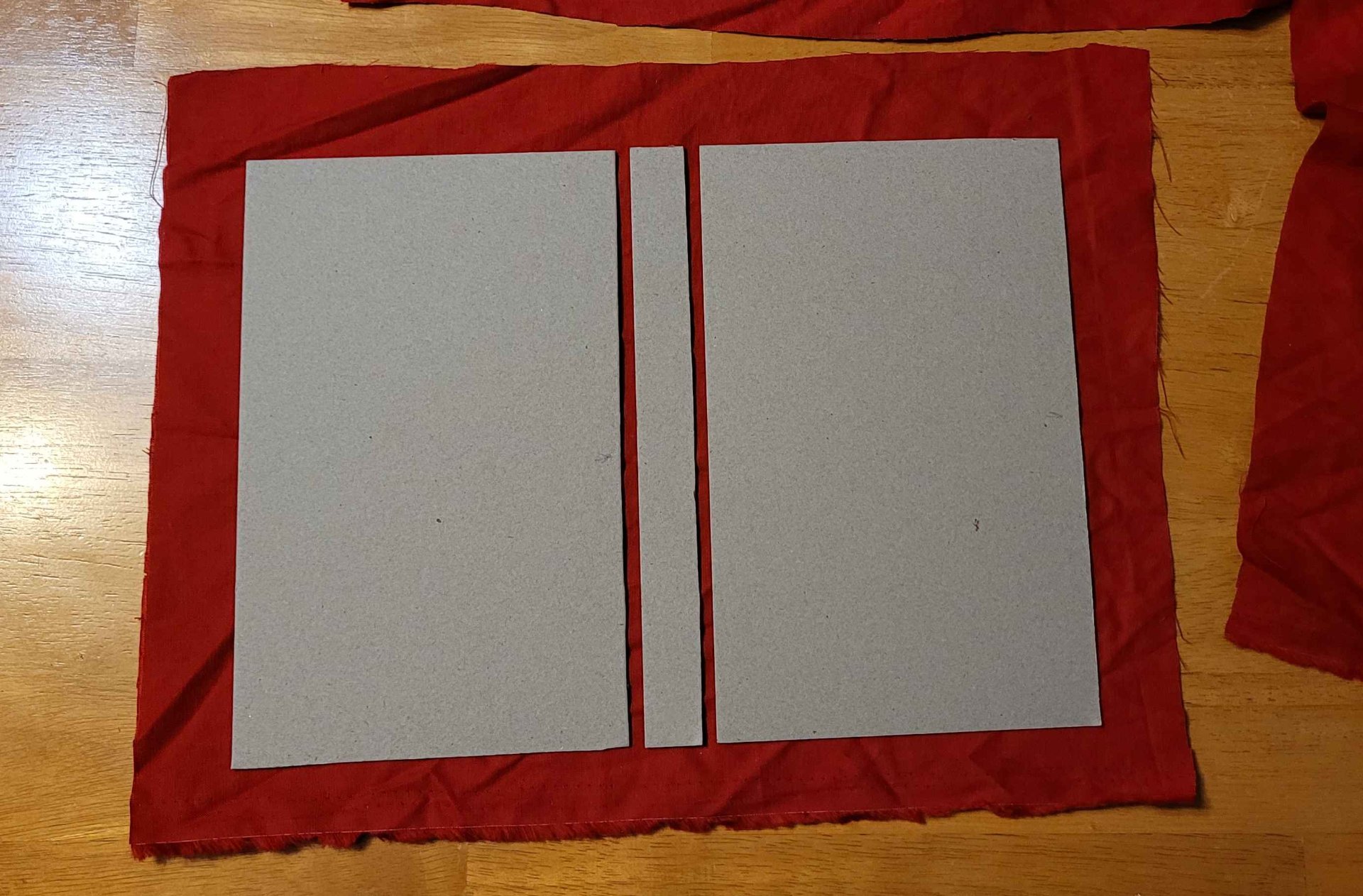 That's the basic layout but I wanted the color to be darker. I was reusing fabric I bought for a halloween costume, but I was picturing more of a maroon color. I didn't want to buy new cloth when I had a bunch on hand I wasn't using, so I decided to dye this piece. I started off trying to use some very old, expired, dark roast, decaf coffee, but the cloth just wouldn't take the stain, likely due to not being natural fibers. So instead I switched to using some old rit dye I had. I took lots of pictures for the coffee and almost none for the rit dye, so just pretend it's slightly blacker and in a different pot. And that I'm using a stick instead of a wooden spoon.  The nice thing is the rit dye isn't really going to go bad, so I just poured it from the old pot I used (we stopped cooking with it because the nonstick lining had started to flake) into an old jug. I've actually reused it since and it worked fine!  After a lot of hassle, the rit dye finally made the difference. I ironed the cloth to smooth it out: 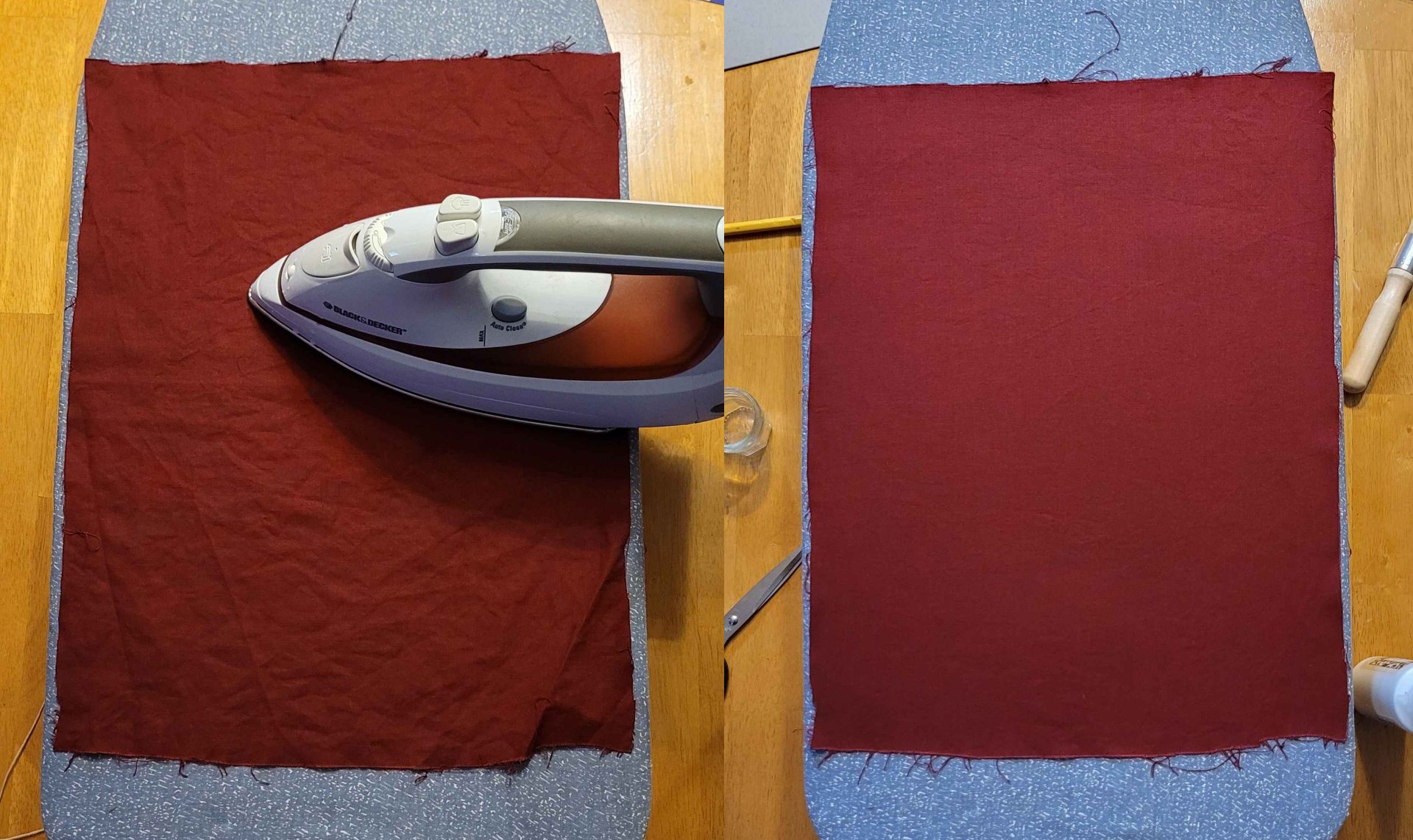 And glued the bookboard down onto it. Make sure the gaps between the spine and the front and back is 6mm and that they're square/in line with one another. 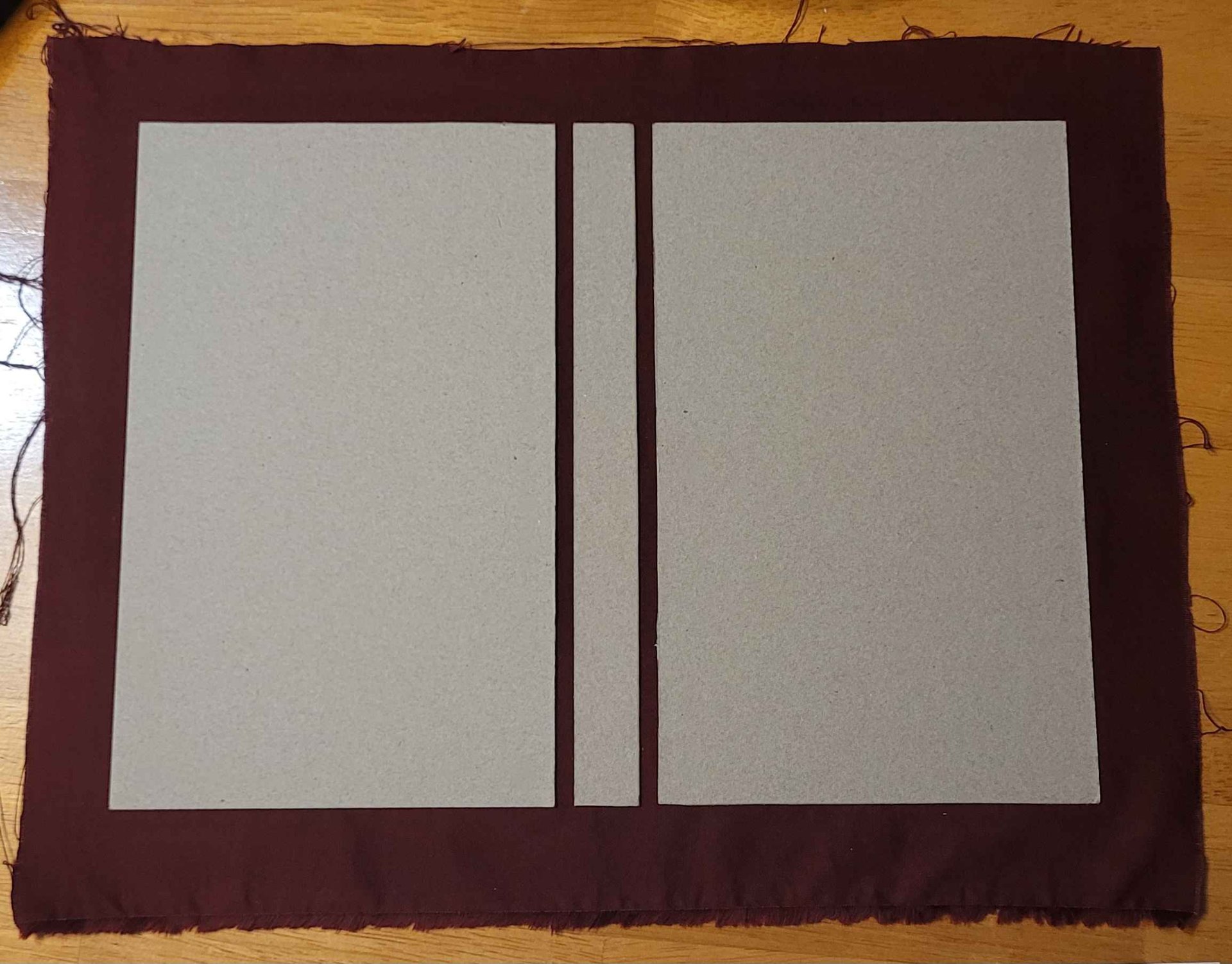 The next step is to trim 45s off the corners (leave one bookboard's thickness between the corner of the bookboard and the cut edge) and to clean up the edges. Then I applied glue to the bookcloth and bookboard and wrapped each edge over: 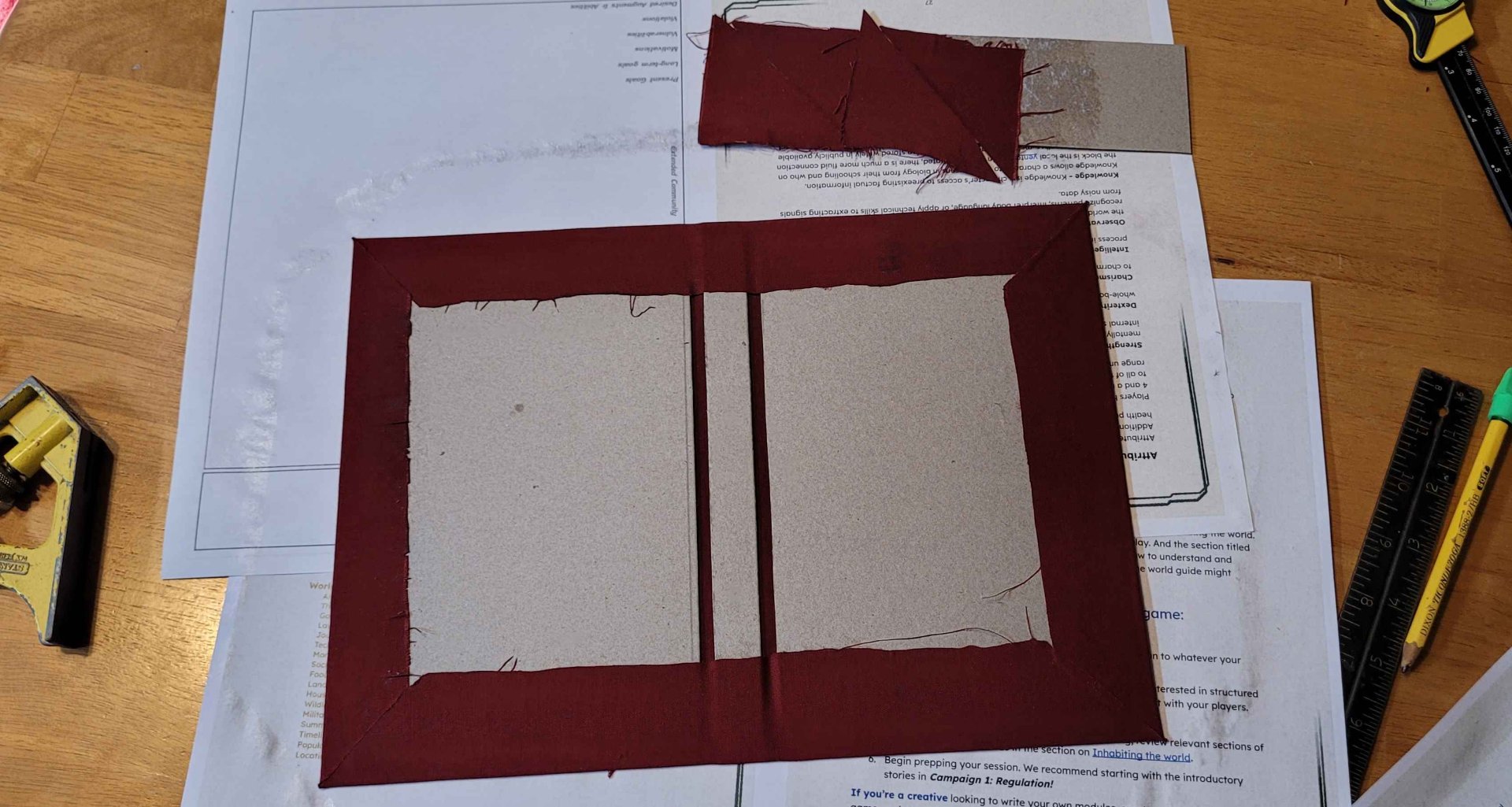 My attempts at this look kinda crude, but you don't really see this once the endpapers are glued on, so it doesn't bother me yet. Someday I'll probably look back on it and wonder why I thought this was good enough, but for now, it works just fine. (You might notice that I glued the cut-off triangles to a scrap of bookboard, that'll come into play later) When you apply glue to the endpapers they'll kind of liquify a little and stretch, so trim a couple mm off the leading/open edge. It'll look better. Okay, final assembly. This is where it all comes together or goes horribly wrong. 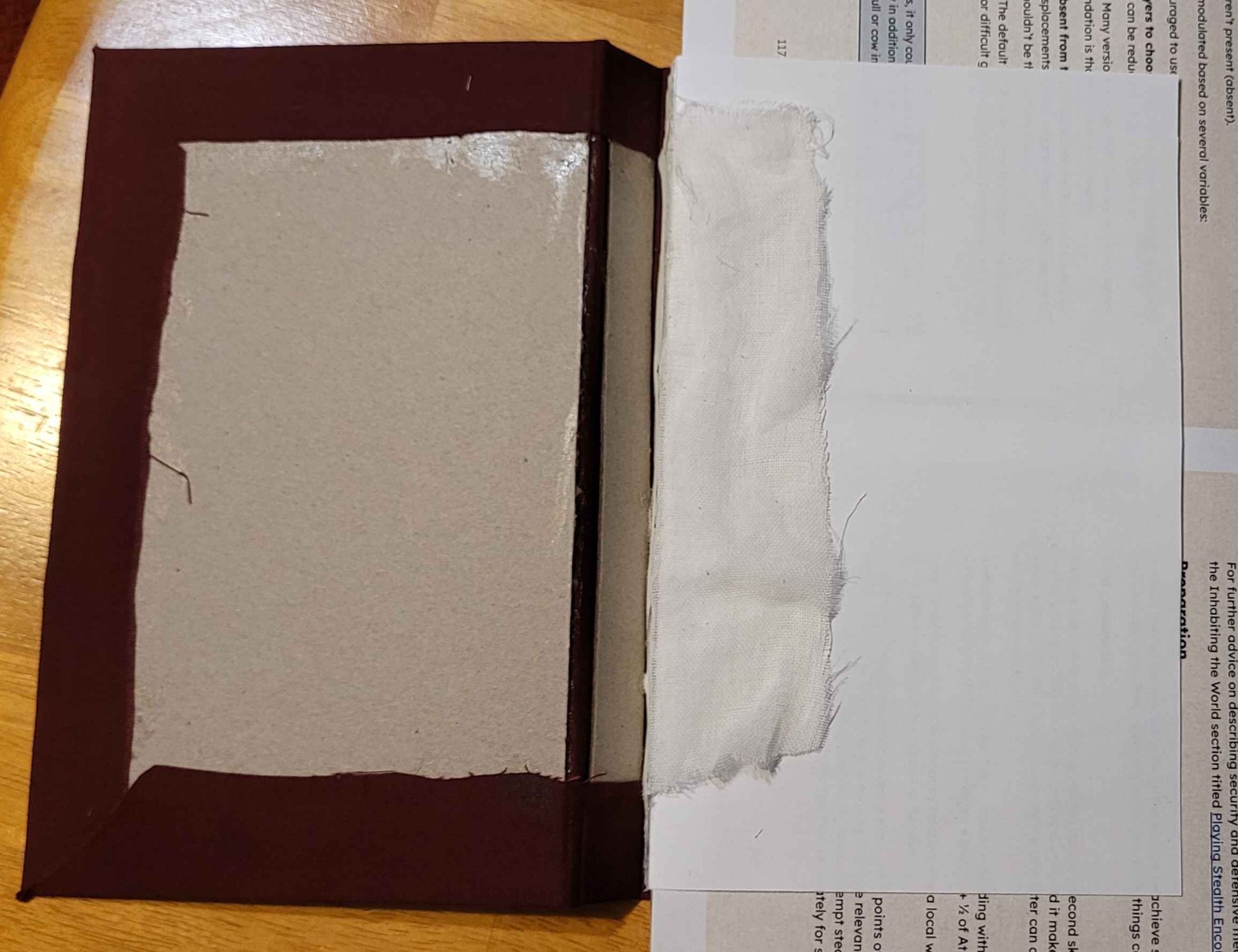 To do this you place the bookblock inside the cover and get it positioned how you want it. Open up the cover again, slide a piece of wax paper and a piece of scrap paper in between the topmost endpaper and whatever's underneath it. Make sure the scrap paper is on top. Get your brush soaked with glue and then dab it on some scrap until its not really soaking where it hits. Use little vertical jabbing motions (Psycho style) to stipple the top paper so its completely glued. Apply glue under the mull/cheesecloth, then put the cloth in place, then apply glue on top of that. When there's a good layer of glue everywhere take a deep breath and close the cover onto the page. Open it just a crack, look for wrinkles and smooth them out as best you can. If you open it too far the paper will pull away from the cover. When you think you've got it as good as it's going to get, remove the scrap paper but leave the wax paper. Close the book, put something heavy on it, and hope for the best. When its dry, flip it over and repeat the whole process. We've now hit all the usual steps (except the end ribbon thing but I don't see the point of that). I was honestly very pleased with the results. 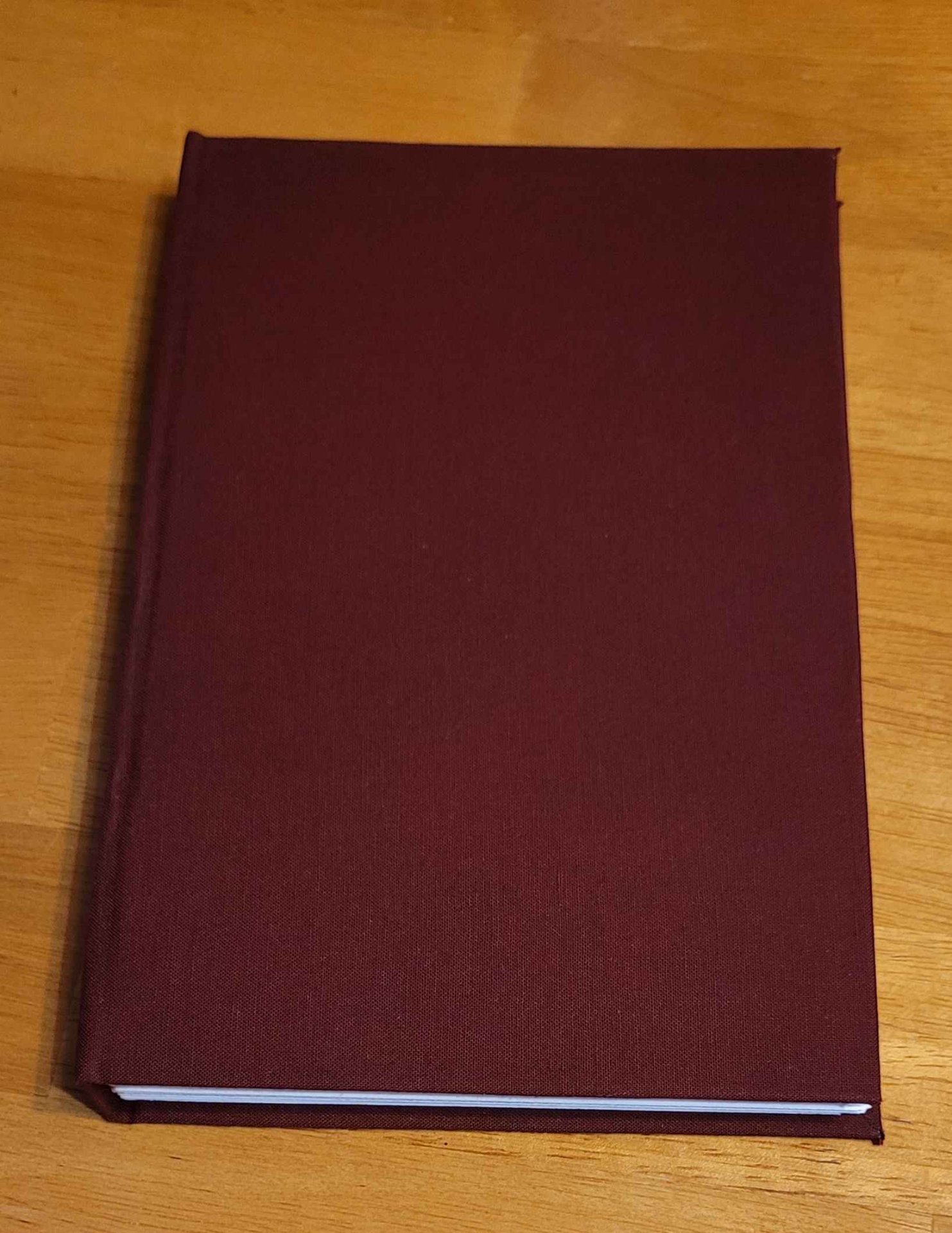 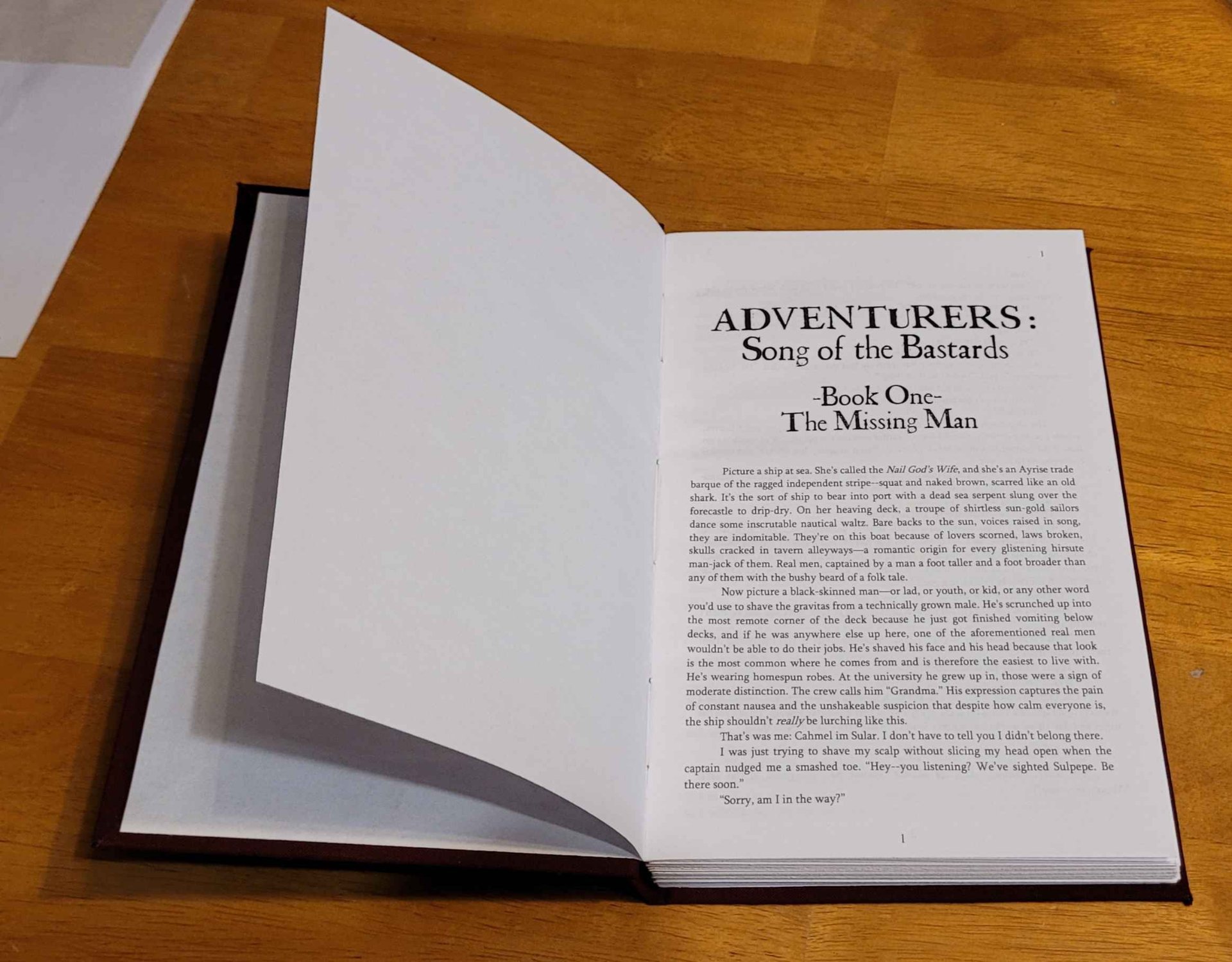 But lets get fancy with it. I had some time on the CO2 laser cutter at my local makerspace, and I'd seen online that people had managed to etch bookcloth, so I wanted to try finishing things that way. We started with some tests, on very low power and working our way up. We weren't sure how well the poly-blend fabric would handle the laser, or what kind of damage it would cause. 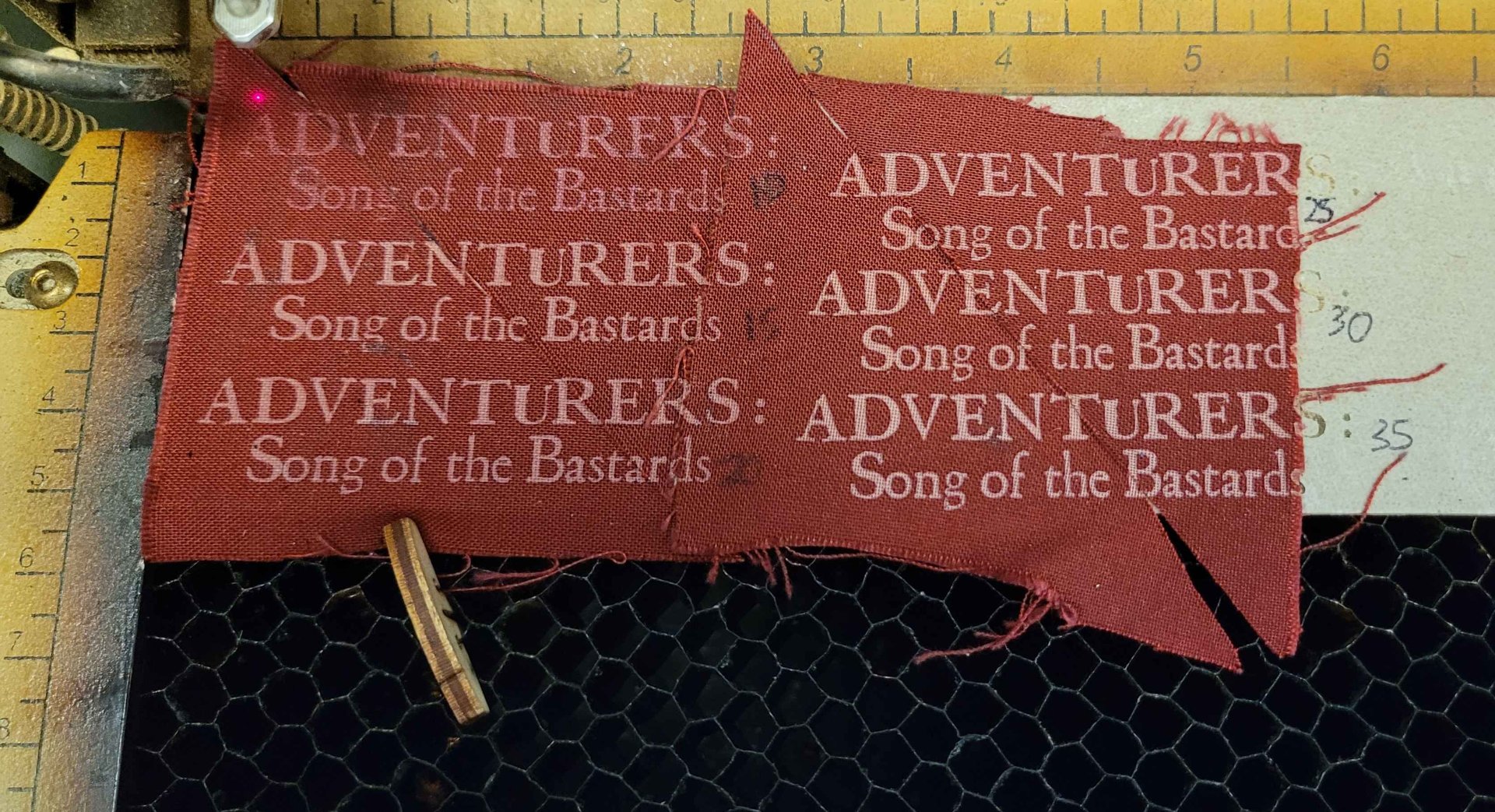 We started with the settings for printer paper (95 speed, 10% power) and worked up by 5% increments, finding that the quality improved each time. Once that was done, I banged out a quick cover layout by measuring the book, drawing a vector rectangle in those dimensions, and positioning the raster title in the middle. We ran it with the lid open (runs as a test with just a visible dot) and made sure the rectangle followed the edges of the book. I had to prop the cover open a little so it'd be more level (I used one of the little connector things we use to pin warped things to the work surface). Then it was just a matter of hoping for the best and rerunning the file with the lid closed.  It was kinda high stakes but I'm very pleased with how it tuned out. #diy #bookbinding #lasercutter #etching
cross-posted from: https://slrpnk.net/post/12735795 > Hi! I'm hoping to hear people's thoughts on what my city, New Orleans, would look like in a perfect solarpunk world. > > Most solarpunk art (which I love to see!) Seems to be praire/plains or forest inspired, and definitely one of the issues we have that I want to avoid is people bring environmental and ecological policies and thoughts from those two biomes to other ones (because they're seen as kind of default). > > So, New Orleans! Lots of interesting challenges to address, including: > > -tornados (so we need safe rooms and to withstand them > > -hurricanes (there's probably no way to withstand these, instead maybe something that's kind of designed to be refixed once a year, since that's what happens anyways) > > -flooding, both hurricane-associated and flash-flooding throughout the year (definitely no basements, honestly maybe no first or second floors either). > > -extreme heat (feels-like gets to 120F/50C at least a couple days a year) > > -extreme cold (not nearly as bad as the heat, but can be brutal enough that they turn schools into extra shelter for our > unhoused for about a week each year) > > -end of the river (we're at the end of the Mississippi, so we're definitely more silt than soil) > > -swamp (New Orleans is sinking, our ground isn't particularly stable) > > -agriculture (I'm really not sure farming is a great idea. It's hard to find local crops that grow in the wetlands--even lists of indigenous foodways focus more on upstate, where traditional planting would work. Can we farm in the wetlands without turning it into a farm?)
I recently started making [solarpunk postcards](https://jacobcoffinwrites.wordpress.com/postcards-from-a-solarpunk-future/) again, and I had a lot of fun with a quick scene of [a solarpunk cargo ship](https://slrpnk.net/post/12556831) (a steel-hulled, four-masted barque) in a storm. I'd like to do more but don't yet have any strong points to make or designs I'm excited to feature. So what would you like to see? What scene is missing from solarpunk art of humans interacting with oceans, rivers, lakes, canals? What weird idea, or old, practical design should make a comeback? I can't promise that I'll make everything but I really do try to include as many suggestions as possible. So far suggestions from reddit and discord have included: - Showing more of the mooring ropes and foundations festooned with underwater life (perhaps in another storm or low tide?) - Boats or ships with [soft wing sails](https://www.boatdesign.net/threads/the-design-of-soft-wing-sails-for-cruising.49425/) which are apparently good (in theory) when it comes to performance as they maintain their shape regardless of wind conditions. - edit to add: a [clipper ship](https://www.bairdmaritime.com/shipping/dry-cargo/vessel-review-grain-de-sail-ii-french-transport-companys-cargo-sailship-built-for-trans-atlantic-crossings) I'll state up front that I'm not a nautical kinda guy. I like to pick up terminology and learn but I've never sailed anything larger than a sunfish and I see the ocean maybe once every five years. So feel free to spell out practical considerations and realism stuff because I probably won't think of it. And thanks!

I’ve been [wanting to do scenes of solarpunk ships and shipping](https://slrpnk.net/post/3123093) for awhile now. I love reexamining old technologies and seeing if they could work again, mixed with modern advancements, especially in a society with different values, or one that uses more metrics than just money to make their decisions. I’ve read about the various attempts to make container ships more green with massive sails and kites and alternative fuels, but I never really loved any of them enough to make art of them. At best, they seemed to promise that they might use somewhat less fuel in the future, but they seem committed to the basic container ship format because its so efficient (in cost) and because everything is optimized around it. I was talking with some of the folks from Fully Automated! about future weather changes, megastorms and tsunamis (and the potential for tsunamis to set off undersea avalanches that cause more tsunamis) and the damage those could all do to ports. How all that carefully-optimized equipment, even the depth of the ports themselves, could be damaged suddenly. I started to think about solarpunk ocean scenes again, and about smaller vessels (which could perhaps use the shallower ports) could operate largely by wind, more or less traditionally. Can the concept of container ships fit solarpunk? I genuinely like the optimization and logistical advantage of using standardized, stackable shipping containers which fit on ships, trucks, and trains without the need to load and unload the cargoes by hand at each transition in their journey. That’s great stuff, no complaints. What I wonder about is if that cost efficiency has caused other problems. We ship cargo all over the world but much of the time, we do it because it’s so cheap to do so. We ship raw material from one continent to process it on another, we ship that material again so we can shape it into parts, which are shipped back to the second continent for partial assembly, and then for final assembly on a fourth. Is that efficient? It’s cost efficient. But we burn terrible amounts of fuel each time we do it, and we do it for so many things. So I’m skeptical. Alright, my complaints out of the way, what’s actually in this scene? We’ve got an offshore windmill and a steel-hulled, four-masted barque with what’s hopefully an open-source variant of DynaRig sails. So what does that mean? I’m very much not nautical – as with most of my postcards I’m doing my best to combine a bunch of concepts I’m only newly familiar with, so I’ve tried to make sure they’re at least based on reasonable starting points: Cromlyngames in the FA! team mentioned DynaRig sails, these kind of funny-looking sails that taper towards the base, with thick masts and curved yards. They’ve seen some limited use on expensive yachts, there’s some [proposals/plans](https://www.dykstra-na.nl/designs/wasp-ecoliner/) to use them on container ships, and do seem to work well from what I’ve read. Their main advantage is in labor-savings and safety – [the sails apparently slide out from inside the masts following tracks in the yards](https://www.youtube.com/watch?v=KZoS93qkZHw), so nobody has to climb the rigging to raise or lower them. And the entire mast rotates to best catch the wind. This allows for a smaller crew, and less of the traditional risks. Crom suggested that they could work with any square-rigged ship, and a quick perusal of some nautical and sailing forums agreed with that (and taught me what those were). I started reading about traditional maritime shipping, and eventually found a forum discussion about the potential return of sail to modern day shipping. A [poster on there mentioned](https://forums.sailinganarchy.com/threads/cargo-sailing-ships.238388/) the [Passat](https://en.wikipedia.org/wiki/Passat_(ship)), a German Flying P-Liner, and I was delighted to learn that a whole set of steel-hulled sail ships were hauling cargo well into the 1950s. Heck, [one of them](https://en.wikipedia.org/wiki/Pamir_(ship)) was captured by New Zealand during WW2 and put right into service hauling construction supplies. So I borrowed the hull. IRL, I’m sure there’s a ton of quality-of-life improvements ship designers and sailors could suggest for a modern barque, and I’m sure I’ve included some stuff that doesn’t belong, but I’m just happy to have found a sail ship that was still effective in fairly modern days. In fact, it looks like staffing (both the difficulty finding qualified crew, and changing laws requiring more crew than traditional) was a big factor in the end of their service, and that’s something I suspect the modernized sails could help with. I’d like to do more nautical scenes, so if you have improvements or alternative designs, let me know! I think I might do one with an offshore windmill substation, a [clipper ship](https://www.bairdmaritime.com/shipping/dry-cargo/vessel-review-grain-de-sail-ii-french-transport-companys-cargo-sailship-built-for-trans-atlantic-crossings), or anything else you think would be worth showing. I know there’s been a ton of tech and safety features invented and added to ships since the P-Liners were modernized, and I think those things could help shorten their journeys and improve their safety at sea. Art stuff: usually, unless I already have a strong plan for the visuals, part of my research is looking up various real life postcards and other art of similar content for inspiration. People have made postcards of almost everything. There’s no shortage of paintings of ships at sea – I started this as a peaceful, sunny scene, but eventually gave in and went for a dramatic storm instead. Maybe showing the ship in a storm weakens the point a little, but ships run into bad storms even now, with all our modern day early warning systems – you can see plenty of videos online of even massive container ships losing cargo from being heaved around by the weather. And one of my goals is to show weather, seasons, and locations that Solarpunk art doesn’t often feature. Bad weather is a fact of life, and it’s likely to get even more wild as our climate changes. I’ve done a [couple](https://jacobcoffinwrites.wordpress.com/2023/11/06/ropeway-over-a-seasonal-road-winter/) [scenes](https://jacobcoffinwrites.wordpress.com/2024/01/03/woodgas-plow-truck-filling-a-village-snow-vault/) of blizzards, but none of terrible rains yet. Given the premise that this is a postcard from a solarpunk future, it might be a historical scene of a famous ship that survived a hurricane, perhaps in the moments when the storm blew it dangerously close to an offshore wind farm. This image (and all the other [Postcards from a Solarpunk Future](https://jacobcoffinwrites.wordpress.com/postcards-from-a-solarpunk-future/)) is CC-BY, use it how you like.

This was another of those still images, where I wanted to capture a specific kind of place, the old farmhouses you find all throughout my hometowns, and a specific time of day in November when the sun has set and everything is this almost monochrome purple but the grass and crops look almost tan. In a few months, on cold grey days like this, when there’s a layer of snow on the ground, it almost mirrors the sky with just dark trees between them. But for now it’s this very specific color. I used to go for walks or snowshoe trips most afternoons, and would often find myself hurrying to get back as night settled in. On those early evenings, I loved the yellow lights in the distance, the warmth and human routine they contained. I wanted the farm in the comic to be a little more active than some of the ones back home. I did a fair bit of reading about agriculture UAVs and autonomous tractors, and I very much liked the used-future feel of the brand new stuff from those articles being kind of old and hacked-together at this point. Something these folks bought second- or third-hand, probably after it was already hacked by a previous owner to remove the manufacturer’s ability to remotely disable it. I like the idea that they have a sort of workshop/hangar for launching drones and inspecting their crops set up in the loft of the barn. The standing figure is based a bit on my grandfather. If want to read the rest of this silly rural cyberpunk webcomic about a stolen secret service prototype and the endangered deer it thinks is the president, you can find it here: https://jacobcoffinwrites.wordpress.com/president-deer-adventures/ If you’d like to read the related-but-mutually-non-canonical short story version, you can find it here: https://en.scrappycapydistro.info/harbour it’s in the first edition, on page 3!
Earlier today, I saw this thread on Mastodon: https://writing.exchange/@jannik@norden.social/112965146817661555 In it, the poster wondered what solarpunk cars would look like, and speculated that we already agree that they'd be lightweight small cars with electric drive. I wrote up a few posts in response, and gathered up some reference images, and I think they might be useful for folks looking to add detail to streets in Fully Automated. I'd argue that in a solarpunk world, most personal travel should be feasible with public transit in one form or another, and with bikes or other similar pedal/electric contraptions filling much of the last-mile needs. And FA! offers a wide range of vehicles from ropeways and airbus to trains and streetcars and ferries that fill those various public transit niches. Likewise, most cargo should be being moved by train, airship, or ocean vessel. But that still leaves a lot of gaps: last mile transit, especially for heavy cargo, and personal conveyance for people with disabilities and other needs spring to mind. FA! has some wild/exciting stuff like personal rotorcoptors and gliders here, but what would some of the more mundane vehicles look like? I think with most transportation handled by public transit, car-ready streets are likely going to be de-prioritized, if only as a matter of cost/resource allotment. I picture a lot of them shrunk down to make room for parks, gardens, and sponge-city permeable surfaces and basins, leaving something wider than a bike path, but narrower than our current default. I think we'd see road networks used mostly to reach local destinations, and public transit hubs, and that the vehicles on those roads would generally travel much slower, and could be held to much lower safety standards than modern cars. In real life there are a dizying array of contraptions people come up with in alternative vehicle competitions - hybrid electric, solar, and pedal-powered machines sort of partway between a bike and a car. If the roads are no longer the sole domain of cars and high speed limits, and bikes weren't restricted to narrow bike lanes and paths, I could see people building all sorts of things to suit their needs for local transportation and cargo capacity. Ideally they'd be open source, DIY things which reuse as many existing parts and materials as possible. I've gathered up a few of my favorite examples here: The [vhelio](vhelio.org) modular electric/pedal hybrid vehicle looks pretty crude, but it offers a crazy variety of configurations, I could see some descendant of it, a bit more developed, being common on streets.  Here's another take on the design: 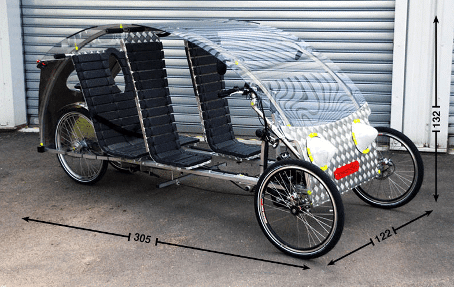 Electric rikshaws are a practical city vehicle, small but with large carrying capacity: 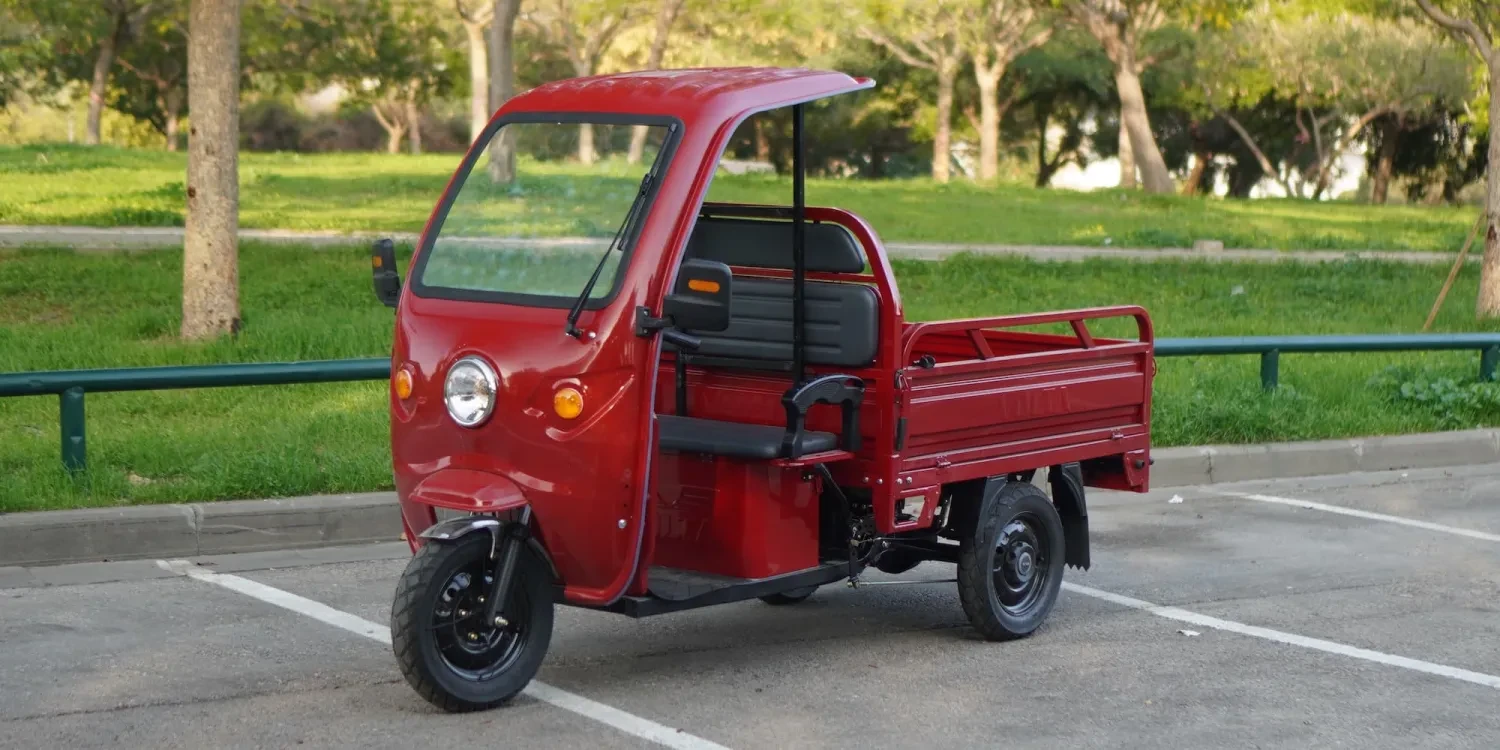 I'm not even sure how much taxonomic difference there really is between them and ebike tricycles: 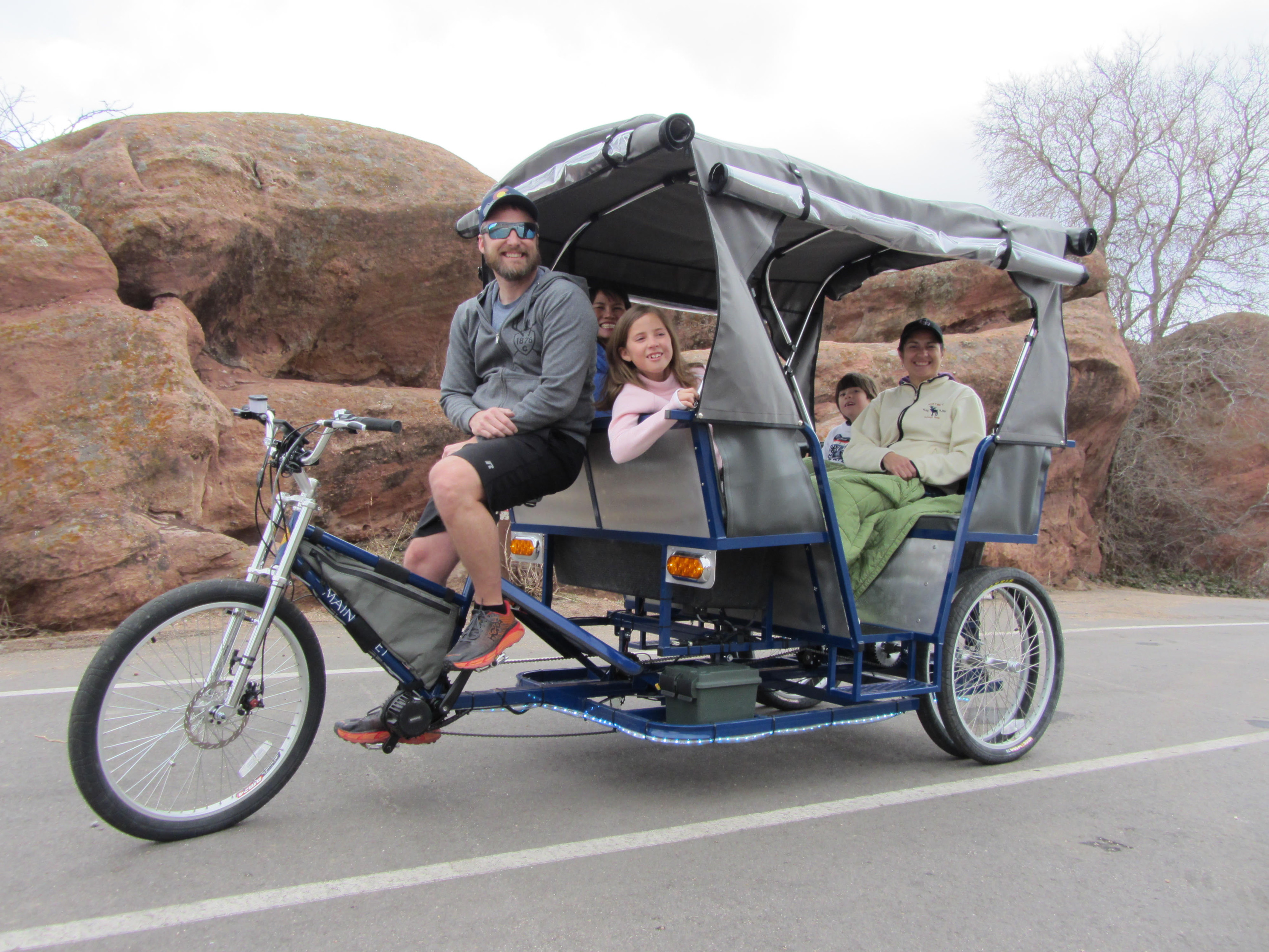 I think the four-wheeled, cargo-hauling, recumbant velov armidillo bicycle cart is especially cool.  We might even see mini-car-like things like the UD MUUV Velocar: 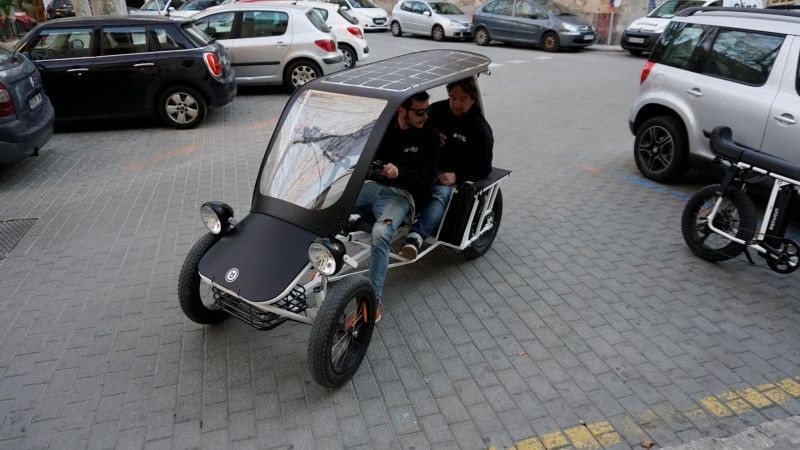 I think the closest fit to modern day vehicles would actually be trucks (albeit often smaller and more utilitarian than many of the giant pickup trucks we have now). But for moving heavy items for the last few miles trucks are a good form factor. I photobashed some art of one using a streetcar pantograph rig, set up to haul heavy stuff for a library of things: 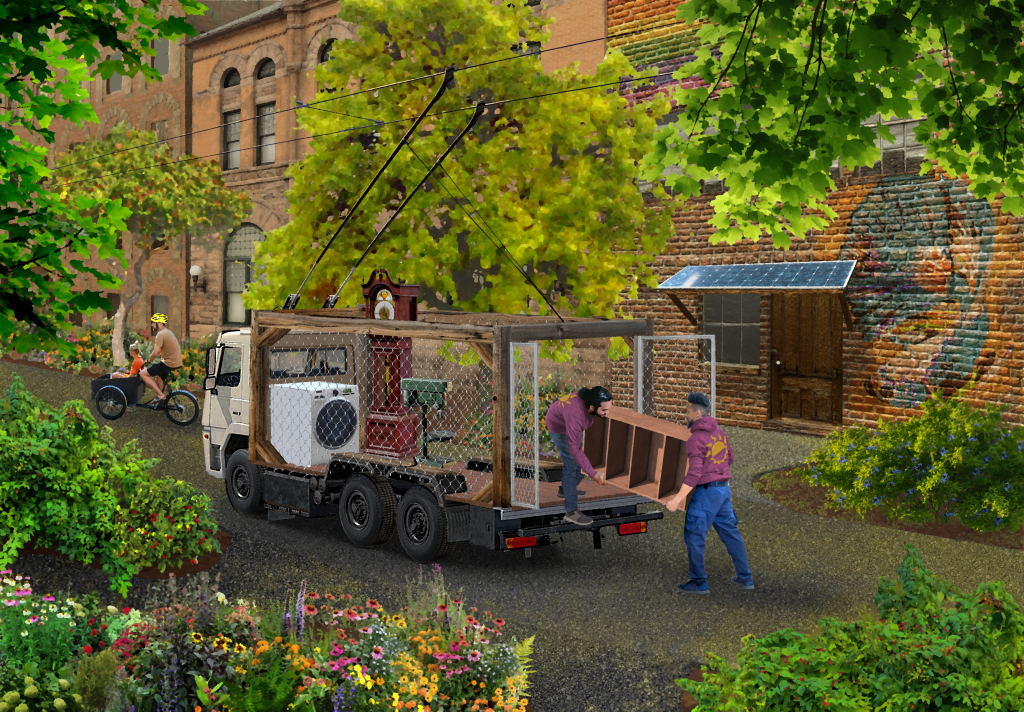 Full post here: https://jacobcoffinwrites.wordpress.com/2024/01/16/library-economy-heavy-items-delivery-collections/ As for what they would look like - if we didn't need every vehicle to be able to fly down freeways and survive 180-mile-per-hour crashes, they could be much simpler than what we have now. Something along the lines of electric kei trucks, small cabs, large beds, not intended to double as a mini van or daily driver. This article had a kind of cool example: https://slrpnk.net/post/11465754 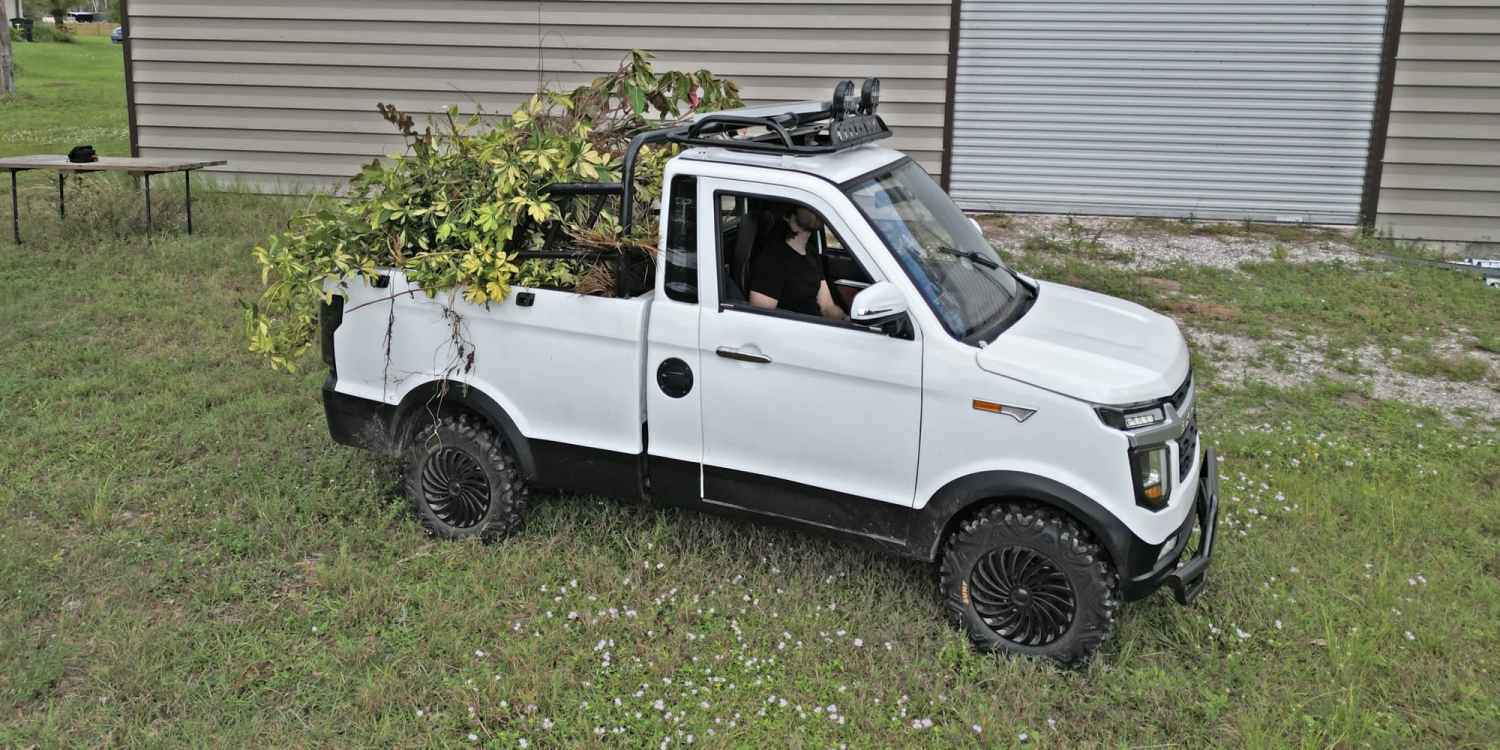 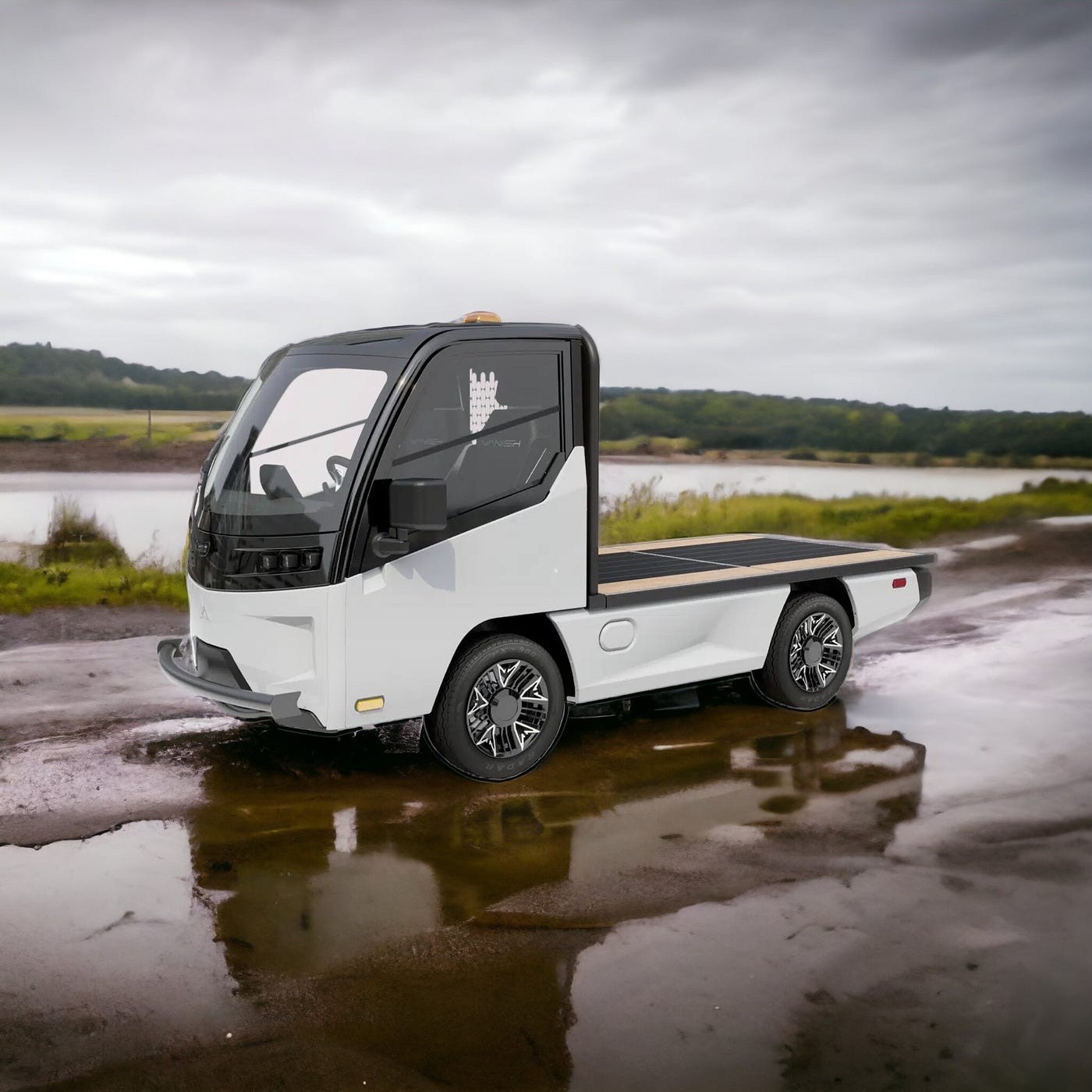 Another potential truck answer is Woodgas conversions of old Internal Combustion Engine trucks. https://solar.lowtechmagazine.com/2010/01/wood-gas-vehicles-firewood-in-the-fuel-tank/ I think these make sense for rural areas, for specific tasks, by farmers, forest managers, and others whose work takes them impractically far from public transit. Woodgas conversions emphasize reuse of existing machinery instead of new manufacturing. It doesn’t require high-tech electronics like electric vehicles. 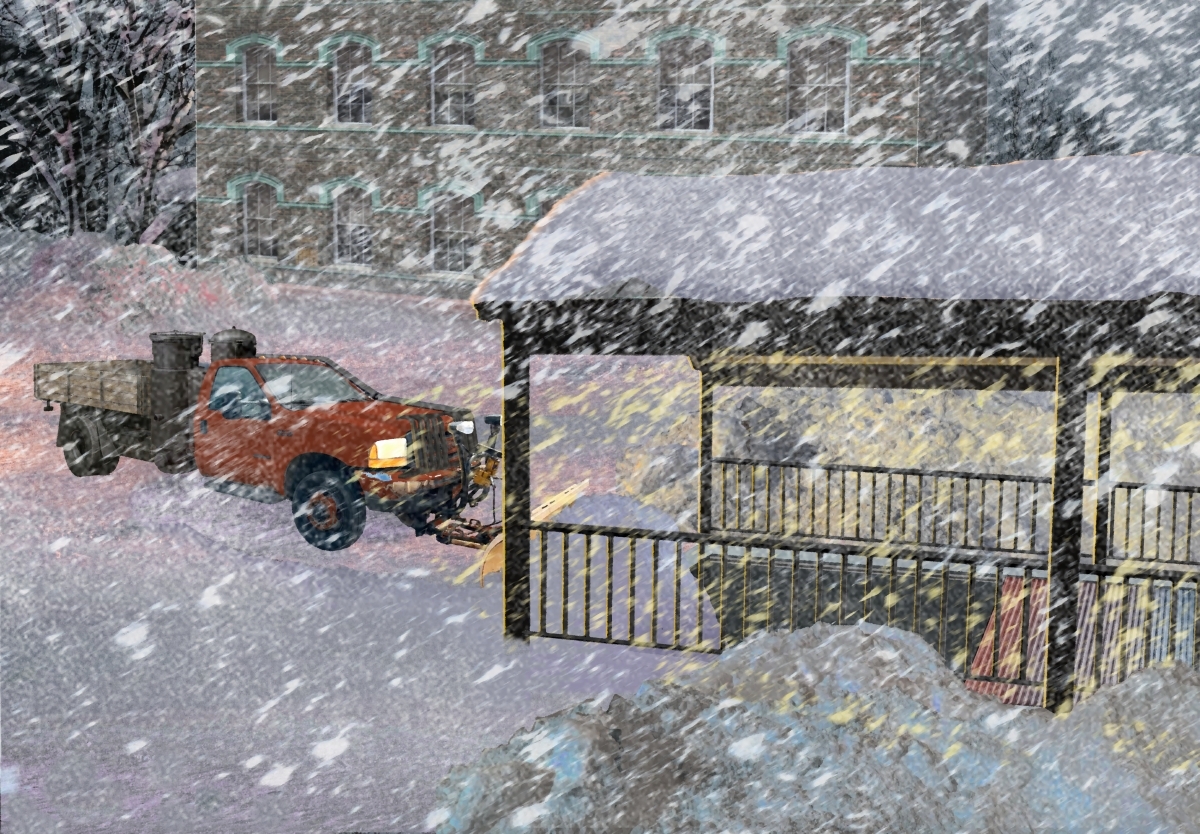 These are less practical for the kind of quick trip to the store or daily commute which has shaped our current society. A woodgas vehicle takes awhile to start up, and because the fire needs to burn down, doesn’t make much sense for short trips. They might be used for hauling produce to town, supplies out to forest management camps, research sites, and other remote locations. And perhaps for road trips by campers and other people who might borrow one for awhile. I could also see hobbyists having a lot of fun with them. The wood could be sustainably sourced, using scraps from sawmills, harvested invasive trees, brush, and even dedicated coppiced plantations of especially fast-growing trees like paulownia elongata. though its important to note that while this can be done well, the last time these vehicles were used in massive numbers (during WWII) they led to deforestation. They make sense in small doses, and with some careful management of their inputs. One last bit of art - I featured a bunch of big woodgas trucks, smaller electric kei trucks, electric rickshaws, cargo bikes, and a modernized chinese wheelbarrow in this scene of McMansions being deconstructed and the materials salvaged in this photobash:  Full text here: https://jacobcoffinwrites.wordpress.com/2024/05/02/deconstruction-crew-disassembling-abandoned-mcmansions-so-the-material-can-be-reused/ edit to add this goofball bicycle-powered car-sized cargo contraption: 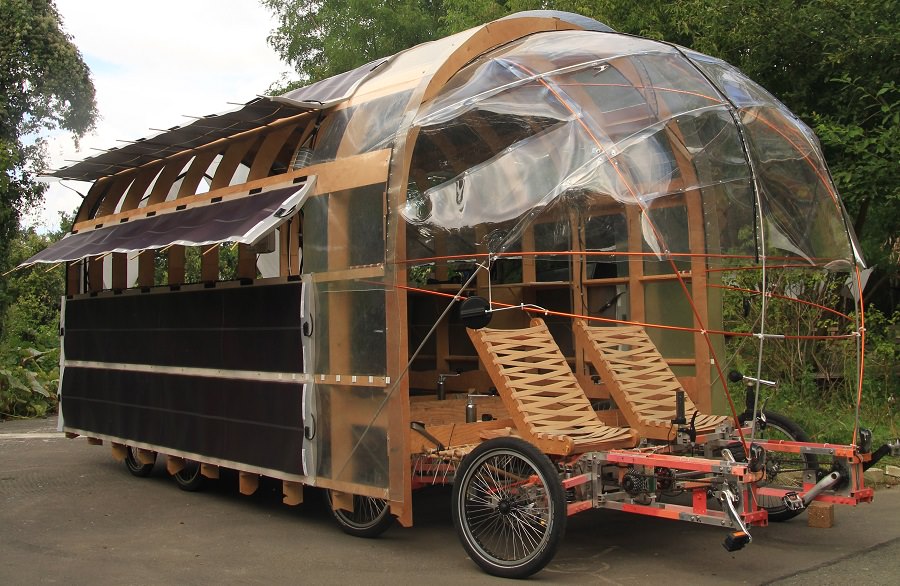 https://www.icebike.org/biggest-cargo-bike/

cross-posted from: https://slrpnk.net/post/12129345 I’ve been working on writing a campaign(?) adventure module(?) For Fully Automated for the last couple months now. It’s the first piece of solarpunk fiction I’ve written, and it includes almost every setting concept I’ve been playing with in my Postcards from a Solarpunk Future series. It’s a sort of treasure hunting adventure, where the players are on a quest to find several tons of illegally-dumped industrial waste, which is useful in the production of geopolymers. Through their investigation they’ll explore a mostly-abandoned town which is in the process of being deconstructed and rewilded, talk to locals and work crews, and hopefully unravel a cold-case murder mystery lost to the region’s chaotic past during the setting’s Global Climate War 60 years before.) Writing this has been really fun - I think partially because I love worldbuilding, so I'm happily writing all the locations and options I can think of, knowing the players will only visit a subset of them. I’ve gotten far enough along that I think I can start photobashing together some art for some of the locations the players might decide to visit (starting with this bike kitchen in the village where the game begins). In my postcard about deconstructing McMansions to reclaim the building materials and rewild the land, a few people brought up simply repurposing the buildings. I’d been batting around the concept in my head for awhile before then, but had struggled to figure out how to render a scene that showed everything I wanted it to. I ended up using pretty much every idea I had for those scenes in the campaign’s starting village (a planned community which has repurposed an abandoned wealth enclave and its golf course as communal housing, workshops, and a food forest. That means I can put together photobashes of specific spots within that village, which I think is more achievable. So here’s the first of the set. It shows a little bit of a repurposed discount mansion, but focuses mostly on the old back yard. The concrete patio has been removed, the large lawns and nearby golf course have grown into proper forests, and public paths have been brought right up to the house. The pool house has been turned into a bike co-op, and the swimming pool has been converted into a sunken greenhouse or Walipini. Generally when you end up with an old swimming pool you don’t want, your options are to tear it out and fill in the hole, just fill in the pool, convert it into a natural pond, or (perhaps the least common answer) build one of these. Which one you pick will likely depend on your goals, the quality of the structure, and how far down your water table is. If it’s too high, it can lift an empty pool like a concrete boat, or cause other structural damage. But if circumstances are right, and the pool is intact after being abandoned and empty for a good many years already, it might be worth repurposing. There are some beautiful and solarpunk photos online of [real life versions](https://www.urbangardensweb.com/2017/08/26/transform-disused-swimming-pool-garden/) of these, which have a far grander scale than what I’ve depicted here. This is more like the old pineapple pits, or a fancy version of the [citrus trenches](https://solar.lowtechmagazine.com/2020/04/fruit-trenches-cultivating-subtropical-plants-in-freezing-temperatures/). Who knows, maybe they even cut away part of the floor so they could plant into the ground below. The above-ground portion of the greenhouse is backed with an earthen berm/raised bed meant to help it maintain a consistent temperature. The retaining walls of the tiered bed are made from [repruposed, broken-up concrete (sometimes called urbanite)](https://slrpnk.net/post/11909269), likely sourced from the concert patio which was replaced with wood chips for better water permeability. Some full-shade plants like rhubarb and mint have been planted on the back slope, and a grape arbor has been built over it. Sweet peas are growing along the side where there’s more light. Raspberries and wildflowers grow around the rest of the smaller yard space. In the background of the scene, an old pool house has been converted into a bike kitchen, one locations where the players will be able to obtain transportation. A network of paths have been built all throughout the village, the food forest, and the region beyond. Even the town the players will explore is riddled with small trails and paths which the locals have built in lieu of trying to maintain a full network of paved roads. This was inspired by my hometowns' network of backwoods trails, and the downsizing to achieve a maintainable transportation network described in [this article](https://solar.lowtechmagazine.com/2011/12/how-to-downsize-a-transport-network-the-chinese-wheelbarrow/). Some roads obviously still exist because they're useful, but others have been washed out and never repaired because none of the current residents need them for anything, while new trails cut straight through properties nobody has lived in for decades. The buildings are painted with colorful murals. This is always a challenge for me in these photobashes. I love the idea of a society that makes art everywhere for its own sake and I'd hope a solarpunk society would abandon some of the obsession with property values and would decorate everything from buildings to machines, in all kinds of styles. That might mean folk art with historical roots, like the [zapista murals](https://danestrom.com/the-zapatista-murals-of-oventic-mexico/), it might mean carved panels on cabinets, or etchings on tools, metal sculpture, or who knows what. Embellishment not for commercial value but as self expression and messaging. So the topics and content would vary a lot. I think there's a bit of punk in that, in refusing to paint or decorate with an eye on the resale value, like your house is a product for others rather than your own home. So I try to include murals, carvings, and other decorations in my solarpunk art. Unfortunately I've also found that in my postcards, where the buildings are usually part of a cluttered background, murals can kind of act like [dazzle camouflage](https://en.wikipedia.org/wiki/Dazzle_camouflage), making it hard to tell what exactly is happening. So I'm still figuring out what works and what doesn't. (Ideally, I want the contents of the mural to be clear while also allowing for the building and the assorted stuff attached to it (plants, solar panels, other tech) to be easily recognized and understood. It's challenging and something I might revisit someday. I did try a version where the bike kitchen's mural was made out of silhouetted bike parts, but it looked less obviously like a paint job on a building, so I went with the mandala for clarity for now. Overall I think this'll work for now, and get us closer to a playable version, though I am still messing with it, looking for something that'll hit that adventure story vibe visually. I'm going much more line-art-and-flat-colors for the character portraits, so we'll see if that works here.

cross-posted from: https://slrpnk.net/post/12129345 I’ve been working on writing a campaign(?) adventure module(?) For Fully Automated for the last couple months now. It’s the first piece of solarpunk fiction I’ve written, and it includes almost every setting concept I’ve been playing with in my Postcards from a Solarpunk Future series. It’s a sort of treasure hunting adventure, where the players are on a quest to find several tons of illegally-dumped industrial waste, which is useful in the production of geopolymers. Through their investigation they’ll explore a mostly-abandoned town which is in the process of being deconstructed and rewilded, talk to locals and work crews, and hopefully unravel a cold-case murder mystery lost to the region’s chaotic past during the setting’s Global Climate War 60 years before.) Writing this has been really fun - I think partially because I love worldbuilding, so I'm happily writing all the locations and options I can think of, knowing the players will only visit a subset of them. I’ve gotten far enough along that I think I can start photobashing together some art for some of the locations the players might decide to visit (starting with this bike kitchen in the village where the game begins). In my postcard about deconstructing McMansions to reclaim the building materials and rewild the land, a few people brought up simply repurposing the buildings. I’d been batting around the concept in my head for awhile before then, but had struggled to figure out how to render a scene that showed everything I wanted it to. I ended up using pretty much every idea I had for those scenes in the campaign’s starting village (a planned community which has repurposed an abandoned wealth enclave and its golf course as communal housing, workshops, and a food forest. That means I can put together photobashes of specific spots within that village, which I think is more achievable. So here’s the first of the set. It shows a little bit of a repurposed discount mansion, but focuses mostly on the old back yard. The concrete patio has been removed, the large lawns and nearby golf course have grown into proper forests, and public paths have been brought right up to the house. The pool house has been turned into a bike co-op, and the swimming pool has been converted into a sunken greenhouse or Walipini. Generally when you end up with an old swimming pool you don’t want, your options are to tear it out and fill in the hole, just fill in the pool, convert it into a natural pond, or (perhaps the least common answer) build one of these. Which one you pick will likely depend on your goals, the quality of the structure, and how far down your water table is. If it’s too high, it can lift an empty pool like a concrete boat, or cause other structural damage. But if circumstances are right, and the pool is intact after being abandoned and empty for a good many years already, it might be worth repurposing. There are some beautiful and solarpunk photos online of [real life versions](https://www.urbangardensweb.com/2017/08/26/transform-disused-swimming-pool-garden/) of these, which have a far grander scale than what I’ve depicted here. This is more like the old pineapple pits, or a fancy version of the [citrus trenches](https://solar.lowtechmagazine.com/2020/04/fruit-trenches-cultivating-subtropical-plants-in-freezing-temperatures/). Who knows, maybe they even cut away part of the floor so they could plant into the ground below. The above-ground portion of the greenhouse is backed with an earthen berm/raised bed meant to help it maintain a consistent temperature. The retaining walls of the tiered bed are made from [repruposed, broken-up concrete (sometimes called urbanite)](https://slrpnk.net/post/11909269), likely sourced from the concert patio which was replaced with wood chips for better water permeability. Some full-shade plants like rhubarb and mint have been planted on the back slope, and a grape arbor has been built over it. Sweet peas are growing along the side where there’s more light. Raspberries and wildflowers grow around the rest of the smaller yard space. In the background of the scene, an old pool house has been converted into a bike kitchen, one locations where the players will be able to obtain transportation. A network of paths have been built all throughout the village, the food forest, and the region beyond. Even the town the players will explore is riddled with small trails and paths which the locals have built in lieu of trying to maintain a full network of paved roads. This was inspired by my hometowns' network of backwoods trails, and the downsizing to achieve a maintainable transportation network described in [this article](https://solar.lowtechmagazine.com/2011/12/how-to-downsize-a-transport-network-the-chinese-wheelbarrow/). Some roads obviously still exist because they're useful, but others have been washed out and never repaired because none of the current residents need them for anything, while new trails cut straight through properties nobody has lived in for decades. The buildings are painted with colorful murals. This is always a challenge for me in these photobashes. I love the idea of a society that makes art everywhere for its own sake and I'd hope a solarpunk society would abandon some of the obsession with property values and would decorate everything from buildings to machines, in all kinds of styles. That might mean folk art with historical roots, like the [zapista murals](https://danestrom.com/the-zapatista-murals-of-oventic-mexico/), it might mean carved panels on cabinets, or etchings on tools, metal sculpture, or who knows what. Embellishment not for commercial value but as self expression and messaging. So the topics and content would vary a lot. I think there's a bit of punk in that, in refusing to paint or decorate with an eye on the resale value, like your house is a product for others rather than your own home. So I try to include murals, carvings, and other decorations in my solarpunk art. Unfortunately I've also found that in my postcards, where the buildings are usually part of a cluttered background, murals can kind of act like [dazzle camouflage](https://en.wikipedia.org/wiki/Dazzle_camouflage), making it hard to tell what exactly is happening. So I'm still figuring out what works and what doesn't. (Ideally, I want the contents of the mural to be clear while also allowing for the building and the assorted stuff attached to it (plants, solar panels, other tech) to be easily recognized and understood. It's challenging and something I might revisit someday. I did try a version where the bike kitchen's mural was made out of silhouetted bike parts, but it looked less obviously like a paint job on a building, so I went with the mandala for clarity for now. Overall I think this'll work for now, and get us closer to a playable version, though I am still messing with it, looking for something that'll hit that adventure story vibe visually. I'm going much more line-art-and-flat-colors for the character portraits, so we'll see if that works here.

It’s been a little while since I posted one of these. I’ve been working on writing a campaign(?) adventure module(?) For the solarpunk TTRPG Fully Automated (which I’m hoping to release libre and gratis through their channels in a few months) and that’s taken up a lot of my creative time lately. It’s the first piece of solarpunk fiction I’ve written, and it includes almost every setting concept I’ve been playing with in the postcards. (In case you’re wondering, it’s a sort of treasure hunting adventure, where the players are on a quest to find several tons of illegally-dumped industrial waste, which is useful in the production of geopolymers. Through their investigation they’ll explore a mostly-abandoned town which is in the process of being deconstructed and rewilded, talk to locals and work crews, and hopefully unravel a cold-case murder mystery lost to the region’s chaotic past during the setting’s Global Climate War 60 years before.) Either way, I’ve gotten far enough along that I think I can start photobashing together some art for some of the locations the players might decide to visit (starting with this bike kitchen in the village where the game begins). In my postcard about deconstructing McMansions to reclaim the building materials and rewild the land, a few people brought up simply repurposing the buildings. I’d been batting around the concept in my head for awhile before then, but had struggled to figure out how to render a scene that showed everything I wanted it to. I ended up using pretty much every idea I had for those scenes in the campaign’s starting village (a planned community which has repurposed an abandoned wealth enclave and its golf course as communal housing, workshops, and a food forest. That means I can put together photobashes of specific spots within that village, which I think is more achievable. So here’s the first of the set. It shows a little bit of a repurposed discount mansion, but focuses mostly on the old back yard. The concrete patio has been removed, the large lawns and nearby golf course have grown into proper forests, and public paths have been brought right up to the house. The pool house has been turned into a bike co-op, and the swimming pool has been converted into a sunken greenhouse or Walipini. Generally when you end up with an old swimming pool you don’t want, your options are to tear it out and fill in the hole, just fill in the pool, convert it into a natural pond, or (perhaps the least common answer) build one of these. Which one you pick will likely depend on your goals, the quality of the structure, and how far down your water table is. If it’s too high, it can lift an empty pool like a concrete boat, or cause other structural damage. But if circumstances are right, and the pool is intact after being abandoned and empty for a good many years already, it might be worth repurposing. There are some beautiful and solarpunk photos online of [real life versions](https://www.urbangardensweb.com/2017/08/26/transform-disused-swimming-pool-garden/) of these, which have a far grander scale than what I’ve depicted here. This is more like the old pineapple pits, or a fancy version of the [citrus trenches](https://solar.lowtechmagazine.com/2020/04/fruit-trenches-cultivating-subtropical-plants-in-freezing-temperatures/). Who knows, maybe they even cut away part of the floor so they could plant into the ground below. The above-ground portion of the greenhouse is backed with an earthen berm/raised bed meant to help it maintain a consistent temperature. The retaining walls of the tiered bed are made from [repruposed, broken-up concrete (sometimes called urbanite)](https://slrpnk.net/post/11909269), likely sourced from the concert patio which was replaced with wood chips for better water permeability. Some full-shade plants like rhubarb and mint have been planted on the back slope, and a grape arbor has been built over it. Sweet peas are growing along the side where there’s more light. Raspberries and wildflowers grow around the rest of the smaller yard space. In the background of the scene, an old pool house has been converted into a bike kitchen, one locations where the players will be able to obtain transportation. A network of paths have been built all throughout the village, the food forest, and the region beyond. Even the town the players will explore is riddled with small trails and paths which the locals have built in lieu of trying to maintain a full network of paved roads. This was inspired by my hometowns' network of backwoods trails, and the downsizing to achieve a maintainable transportation network described in [this article](https://solar.lowtechmagazine.com/2011/12/how-to-downsize-a-transport-network-the-chinese-wheelbarrow/). Some roads obviously still exist because they're useful, but others have been washed out and never repaired because none of the current residents need them for anything, while new trails cut straight through properties nobody has lived in for decades. The buildings are painted with colorful murals. This is always a challenge for me in these photobashes. I love the idea of a society that makes art everywhere for its own sake and I'd hope a solarpunk society would abandon some of the obsession with property values and would decorate everything from buildings to machines, in all kinds of styles. That might mean folk art with historical roots, like the [zapista murals](https://danestrom.com/the-zapatista-murals-of-oventic-mexico/), it might mean carved panels on cabinets, or etchings on tools, metal sculpture, or who knows what. Embellishment not for commercial value but as self expression and messaging. So the topics and content would vary a lot. I think there's a bit of punk in that, in refusing to paint or decorate with an eye on the resale value, like your house is a product for others rather than your own home. So I try to include murals, carvings, and other decorations in my solarpunk art. Unfortunately I've also found that in my postcards, where the buildings are usually part of a cluttered background, murals can kind of act like [dazzle camouflage](https://en.wikipedia.org/wiki/Dazzle_camouflage), making it hard to tell what exactly is happening. So I'm still figuring out what works and what doesn't. (Ideally, I want the contents of the mural to be clear while also allowing for the building and the assorted stuff attached to it (plants, solar panels, other tech) to be easily recognized and understood. It's challenging and something I might revisit someday. I did try a version where the bike kitchen's mural was made out of silhouetted bike parts, but it looked less obviously like a paint job on a building, so I went with the mandala for clarity for now. Edit to add: this photobash (and all the [Postcards from a Solarpunk Future](https://jacobcoffinwrites.wordpress.com/postcards-from-a-solarpunk-future/)) is CC-BY, use it how you like.
 arcadeblogger.com
arcadeblogger.com
I really enjoy the arcade blogger for the arcade cabinet raid writeups he does, and his step-by-step repair posts. The history aspect is neat too. This is a repair post with a bit of history. Decades ago, to combat ROM-cloning piracy, Capcom started adding a chip to their PCBs that stored encryption keys in memory backed up by an onboard battery. You may see the problem here - batteries are not meant to last forever, and if the chip lost power AT ANY TIME the keys were lost and the game was unplayable. This feels like yet another example of the total disregard corporations hold for the media they own the rights to, in favor of short term profits. We've seen before that many works produced by entire teams would have been lost if not for the efforts of pirates and amateur archivists. To quote the blog: >Its hard to say if Capcom knew this would happen, but then again, the shelf life of most arcade games was months, or at most a couple of years – I guess it wasn’t something they planned for. Fortunately, this is a well established problem with a motivated, technically-minded community looking for a solution, so this early DRM has already been circumvented. The article doesn't go into detail on how they researched and reverse engineered this sabotage, but I might do a little reading and edit the post if I find anything cool. Edit: this seems to have more details and is an interesting read so far: https://arcadehacker.blogspot.com/2014/11/capcom-kabuki-cpu-intro.html?m=1 The gist is that the problem is well solved at this point and there's a small industry of aftermarket components out there that are nearly plug and play. The version the author went with works like this: You desolder the dead battery and replace it. Then desolder the blank sabotage chip. You swap in the aftermarket one and configure it (by using tiny switches) to inject the correct set of encryption keys. Then you slot the blank sabotage chip into the aftermarket one. When the game is powered up, the aftermarket chip restores the encryption keys, the PCB looks for the keys, then successfully used them to run the game files. The cool thing is that the sabotage chip is now functional again on its own. The author spent some time restoring the board to stock, by keeping the sabotage chip powered with another battery while removing the aftermarket chip so it could be used elsewhere. I should appreciate the effort at not wasting any resources but I think it makes sense to keep the de-sabotauge chip as a permanent addition, as it automatically prevents the kind of data loss the company intended. Either way, it's a neat article and I'd recommended reading it. He does a lot of arcade cabinet restorations, but generally sends the electronics away for repair, so this was a neat one. I know tech has come a long way since these were made but there's something to be said for these big, chunky, through-soldered components and the well-documented wiring instructions that often came with them.
 www.bloomberg.com
www.bloomberg.com
The Fully Automated rulebook has some cool ideas on housing. I think this article has nice examples and discussions around features of successful apartment buildings/neighborhoods, including the vertical rather than horizontal stratification, which might be worth considering in solarpunk worldbuilding. cross-posted from: https://slrpnk.net/post/11940937 > [Pocket link](https://getpocket.com/explore/item/behind-the-accidentally-resilient-design-of-athens-apartments)